#if they ever do a modern remake it should and would most accurately be a love story between two boys
Text
But honestly. Why would Nomura choose to start the paopu sharing scene with Sora focused on Riku. Why would Nomura choose to have Sora frowning and reluctant to share paopu with Kairi until Kairi clarifies it doesn’t mean they’re a couple. Why would Nomura not tell the voice actors this scene is romantic if it’s meant to be romantic. Why would Nomura consider not having Sora and Kairi share paopu at all. Why would Nomura choose to have Sora start questioning what romantic love and true love are in KH3. Why would Nomura have Sora notice the parallels between himself & Riku and Anna & Elsa just to begin wondering what he and Riku are (according to the novel, Sora doesn’t feel like ‘siblings’ is the right answer). Why would Nomura directly parallel Riku’s feelings for Sora with Hercules’ romantic feelings for Megara. Why would Nomura choose to not show Sora acting ‘romantic’ (in the eyes of the general audience) with Kairi until after Sora forgets Riku’s true love sacrifice (and arguably other things about Riku) and associates Kairi with his savior — a situation that parallels another romantic Disney tale, The Little Mermaid, and is not unlike Sora associating Namine (and then Kairi) with the person most precious to him in CoM when it’s actually Riku that Namine has replaced in Sora’s most precious memory, the meteor shower promise… another memory that Sora may have forgotten. Why would Nomura choose to show Riku’s true love sacrifice multiple times, emphasizing how important it is, if that moment/memory is not going to be vital later. Why would Nomura choose to visually parallel Riku’s true love sacrifice with the meteor shower promise. Why would Nomura specifically shut down the possibility of Riku/Namine when he’s usually pretty indifferent to shipping. Why would Nomura choose to not have Kairi’s memories hold an important connection to Sora beyond the knowledge that unreality exists, and then in the same breath, give Riku an important, personal connection to Sora through his dreams. Why would Nomura choose to make Riku the only one who can go after Sora, who has the power to save him? Why would Nomura choose to parallel Riku with Cinderella and Aurora whose “dreams lead her to her true love”? Why would Nomura do any of this if Sora/Riku’s not happening.
#me: do NOT get your hopes up#also me:#kingdom hearts#soriku#i hope that dudebro from 9 years ago who said nomura’s waiting for homosexuality to be more accepted/mainstream before confirming sora’s#into men knows they’re a prophet that was living a decade ahead of everyone else#probably getting too deep but it IS interesting that the little mermaid — the original and disney version — were heavily influenced by#gay men struggling with their sexualities#the disney version has a significantly happier ending bc howard ashman#believed in a happy ending for him and people like him#if they ever do a modern remake it should and would most accurately be a love story between two boys#or girls#anyway. i think it’s also significant that nomura has said the characters like aqua or axel are not getting a ton of focus in kh4#and kairi is with these ‘unrelevant’ characters#like not only is she staying behind she’s probably going to be part of the side character b-team that comes in to fight in the bigger#battles later#i hate the way she’s treated in these games but nomura’s making it p clear this way that this isn’t about kairi#this is about sora and riku and possibly probably concluding their stories#since arguably kairi’s story irt sora has mostly wrapped up. that’s probably why nomura chose to have them share paopu#so that nobody would be left wondering if/when it’s going to happen#i didn’t forget nomura paralleling riku & sora with yozora & nameless star#it’s just unclear right now what yozora and nameless star’s relationship is#it leans towards romantic but I’d rather wait for confirmation
828 notes
·
View notes
Text
I Play Spongebob Games for Content!
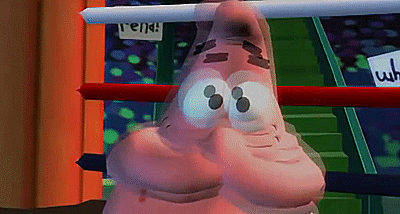
Last week I decided to dust off my PS2 and play some games, I then had the idea to tie it into this blog somehow. My eyes drifted to the bottom of my shelf and there were four Spongebob games I still had from my childhood. No reader I am not a masochist, I'm just a slut for pain. Let's not waste time and get right into it in the order I would've played them in growing up!
Revenge of the Flying Dutchman
This is the first one I ever had and also my introduction to the concept of saving a game. This one follows the story of Gary disturbing the Flying Dutchman's slumber and now Spongebob must find a way to put him back to rest. All the while the Dutchman starts taking his friends to be part of his new crew. I'm gonna say it here, this is the worst game out of the bunch. The controls are just floaty, and the jumping mechanic feels time consuming. The combat is awful, but I think the developers were aware of that so enemies often wait for you to approach, except for the stray snails they charge at you with full force. The character models are really rough around the edges, the worst one is Plankton of all characters.
This game is also doing something to my poor PS2. There are two loading screens back to back and I can hear my PS2 struggling and sweating just to load the inside of the Krusty Krab. It really should not be struggling with a game like this.
The weirdest thing out of this is that the eyes on the characters are individually animated. I don't mean the eyebrows, that would be normal and an easy way to make characters expressive. I mean that the pupils and iris's are individually animated. This only really works with the hypnotizing scenes as the characters are being kidnapped. It gives them a wibbly woobly effect, the effect works nowhere else. All the characters have a lazy eye and sometimes one eye just doesn't move in cut scenes. The game also has a few sound issues with the end cut scene having moments of silence.
Something really surprising is that I have not encountered a single glitch in this one. Props to the dev team for making it actually stable, Lord knows management didn't give a damn.
Battle For Bikini Bottom
Now here's an obvious edition to the list. This was the second Spongebob game I had and it was of course my favorite. It's one of those few licensed games that are remembered fondly and has a dedicated fanbase to this day. So much so that in 2020, the year of misery and hellfire, it got a remake for the modern generation. I played the Switch version for this cry for help that I'm calling a review, and it is what I remember.
BFBB is a standard collect-a-thon wearing Spongebob's skin, that is also fairly show accurate. Most of the voice cast is of course here, except for Clancy Brown, for what ever reason he wasn't in the original and he's still not here. At the same time it would be weird hearing the real Mr. Krabs in this game. There are plenty of good jokes here that have been immortalized into meme culture like Mrs. Puff smuggling stolen art works.
The levels are pretty fun, with plenty of missions and collectables in each to keep you busy. My personal favorite being the dream level that caps off with a joke from Patrick. The worst level though is the Kelp Forest, and it is painful. The stone tikis, and the caves are tedious, and I swear there is no way to beat Mermaid-man's sliding time without breaking the game in some way. I broke the game just trying to do a normal slide down. Honestly I think that this level could've been replaced by something else, maybe the boating school because that school has more appearances than the Kelp Forest.
Aside from my complaints the game still holds up pretty well, with the exception of the performance. I don't know if it's just the Switch version or just an issue with my copy, but as I was playing through it, I saw more and more glitches. At one point I was launched up into the void beyond the sky box, for no apparent reason from what I can tell. I mean I'd still play it again, this type of game tends to be my bread and jam.
Spongebob Squarepants Movie Game
This one was of course put out at the same time the first movie was making its rounds. It is what you'd expect from a movie tie in game, but only in the cut scenes. The cut scenes look and sound like a conglomerate of early drafts, concept art, and unused voice lines from the actual movie. The in game cutscenes are perfectly fine, so I was wondering why they didn't just use that the whole time. Then I remembered that this was probably made on a massive time crunch to make the movie release date. The game itself was made by Heavy Iron who also did Battle for Bikini Bottom, so they share a lot of assets with movie themed additions. Playing through both this and BFBB, it's clear that the enemies were just re-skins of the robots. Even the enemy introductions use the same formula.
Gameplay wise it is just like BFBB minus Sandy, with all the same attacks returning as well. The levels are fun enough, I remember spending a lot of time in Goofy Goobers, just listening to the silly music. The trench levels always peaked my interest, except for the bits where you go into so sort of angler fish, that was a little weird. In the end if you just want more BFBB, this is the game for you if you can look past the cutscenes.
Creature From The Krusty Krab
This was the standout surprise out of the bunch, this game suffers from not enough time and resources, but the creativity behind it is admirable. It's based on the dream episode where Spongebob is bouncing around everyone's dreams. It is a standard level progression system but a handful of these levels have unique art styles that are pleasant on the eyes and pretty creative. The first level is Spongebab having a Twisted Metal racing dream where everyone is drawn with intense expressions while Bikini Bottom is a diesel punk design. The second level is Patrick dreaming about being his self insert character for a super hero comic book, and the town looks like it was drawn in a comic book. Planktons dreams starts out as a pretty standard side scroller before becoming a monster movie, and from then on it is just the monster movie. Spongebob's sections have the most variety, starting as the race level, then he gets eaten by an alaskan bull worm and his next level is in there. What is with these games and having levels inside creatures, is someone into vore? Patrick ends up flying on a rocket in space and
Back to the monster movie bit, this is where the budget really went, it's on the box, it was in the marketing, it is a third of the game. It really worked backwards from the idea of giant kaiju Plankton. Starts with rampaging as Plankton, then Spongebob is flying around trying to find some way to stop him, then Patrick teams up with Mermaid Man to finally take him down. Each one has its issues but also I had a good time with it. Here's something interesting about this game, it has three endings, one for each character. They only unlock if you collect all the little goops for Patrick and Plankton, so a good reward if you like exploring levels.
Playing through this game, it had a lot of potential. No really, if it had more time and resources it could've been a pretty great game. There's mostly a lack of polish, there were a couple of minor bugs when an attack didn't hit when it should have. There were a couple of animation issues, the mayor character glides across the screen, some characters have their feet merging with the floor, and others are really stiff. One thing that was I found annoying was the characters talking a lot during gameplay, all the above have that but this one should have dialed it back a bit. Beyond those issues, this game could have been great, maybe on the same level as BFBB.
Conclusion (It's Passed My Bedtime)
So what did we learn from all this? That my opinion on BFBB was basic and expected? That I may be a masochist? Well yes, but I have found a couple surprises here, like with Creature from the Krusty Krab, I had no expectations going into that one. I had the least expectations for ROFD but it somehow didn't cause a fire despite its efforts, and the movie tie in was just a spin off of BFBB. This is making me reconsider the pile of licensed games festering in the corner, I may have to dig through it to see if I find any hidden gems.
5 notes
·
View notes
Text
FAVORITE MOVIE REVIEWS: #9 THE THOMAS CROWN AFFAIR, John McTiernan
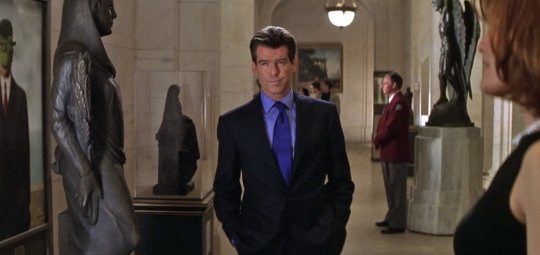
My ninth favorite movie is perhaps my most embarrassing. The Thomas Crown Affair is fundamentally a date movie that happens to be about a heist. And call me a liberal fruit bat, but the film articulates some very problematic values.
However, The Thomas Crown Affair benefits from being one of my favorite movies from my adolescence and does a lot of things right. One of these is its representation of New York City, which is not accurate in detail as much as in spirit.
As an adult I appreciate the relationship between Thomas Crown, played by Pierce Brosnan, and Catherine Banning, played by Rene Russo. There are no easy answers in the movie or in their fun yet troubled romance.
Although The Thomas Crown Affair is shamelessly materialistic its moral strength is its honest amorality. It never mistakes its main characters’ drives with a higher sense of right and wrong, which is sadly becoming the norm in today’s media.

Thomas Crown is a Wall Street Mergers and Acquisitions giant with a fondness for one particular painting--Noon - Rest from Work by Vincent Van Gogh. He affectionately calls it “Haystacks.”
Late for work and stuck in traffic, he leaves his personal chauffeur in front of the Metropolitan Museum of Art to view the painting from a bench the impressionist wing. It should be mentioned that Crown brings a briefcase containing his lunch, which he eats in the museum.
He shows up later in the day at the Wall Street headquarters of his company Crown Acquisitions, having accidentally left his briefcase in the museum. Crown spends the rest of a busy day looking at his watch, waiting for the day to finally end. Crown finally leaves the office with another briefcase and returns to the Met.
I should mention that over the course of the day, a foursome of Eastern European thieves smuggle themselves into the museum hidden inside a Greco-Roman Horse (“Trojan Horse”) preparing to heist the very same wing Crown frequents. Their heist is unrealistically complex--involving crawling through air ducts, sabotaging the air conditioning and an airlift via helicopter.
When Crown arrives, he discovers the nefarious goings on and draws museum security to it. Security thwarts the art thieves before anything is stolen. But not quite.
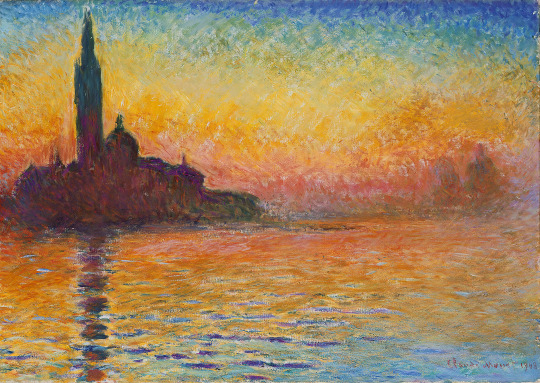
1999 audiences knew from the trailer that Thomas Crown would steal one of the paintings. But in fact, the entire heist was orchestrated by Crown. While the impressionist wing is sealed and the thieves apprehended, Crown slides under the closing gate, steals one painting off the wall and stashes it in a briefcase hidden under a museum bench. He left the briefcase in the Museum intentionally!
And Crown is only able to make his escape because one of the gates is wedged open by the second briefcase he brought work. We later learn the briefcase was loaded with titanium.
Crown does not steal his “Haystacks.” Instead, he steals a painting by Claude Monet San Giorgio Maggiore at Dusk. The movie sets up the painting early on as the watershed painting by Claude Monet that founded the Impressionist movement, worth $100 Million.
(It should be mentioned that this backstory is made up for the movie. The Claude Monet painting that founded the Impressionist movement is named Impression, Sunrise. It is actually housed in Paris and its subject matter is superficially similar to San Giorgio Maggiore at Dusk, though less dramatic.)
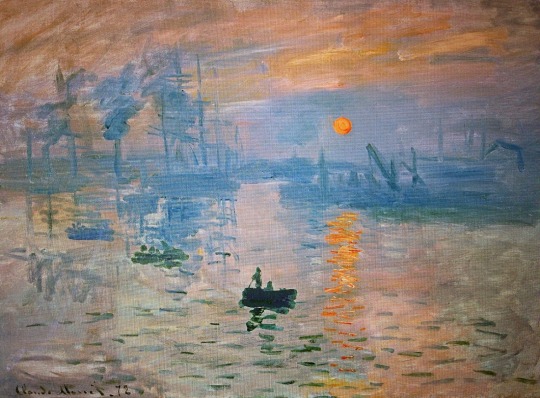
This is our first insight into Crown’s personality. Crown spends the early part of the movie fantasizing of an easier life, like the man enjoying a siesta in Noon - Rest from Work. But it is a facade. Crown is after the drama, dynamism and richness embodied in San Giorgio Maggiore at Dusk.
The above synopsis is only approximately the first twenty minutes of the film. The rest of the movie focuses on the investigation of the robbery. On the case are two NYPD detectives (“Michael”) McCann and Paretti--played by Denis Leary and Frankie Faison.
Having four thieves in custody, they want to treat the case textbook and overlook some of the unusual details. But they are joined within the first hour of their investigation by a Private Investigator named Catherine Banning, played by Rene Russo.
Her job “is the painting.” Already a nuisance to the detectives, she sits in on the Witness ID of the thieves, in which Thomas Crown is the witness. Banning gives Crown several suspicious glances, the gears in her mind turning.
After doing some research Banning discovers Crown has a habit of bidding on paintings by Claude Monet at auctions. She becomes certain that he stole the missing Monet, and after she resolves other details of the robbery McCann and Paretti believe her.
The rest of The Thomas Crown Affair involves Banning’s attempt to retrieve the missing Monet by seducing Crown--who also appears to be seducing her. While the plot develops it becomes unclear to both whether Banning is after the painting or Crown.
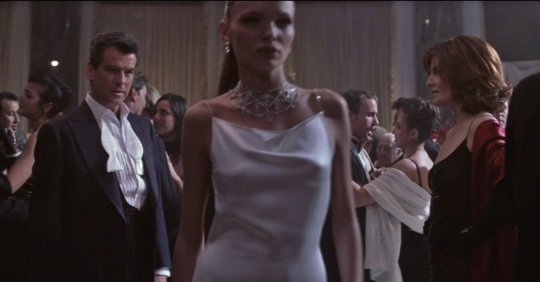
Whether or not The Thomas Crown Affair lands depends on its execution of the romance between Thomas Crown and Catherine Banning. More than half of the movie conforms to the plot structure of any modern romantic film. However, The Thomas Crown Affair deviates from romance tropes in several ways that give the film life where another film’s story and characters would drag.
(SPOILERS BELOW)
This is not to say that there are not several romance tropes littered throughout the movie. For instance, two love triangles are forced throughout the movie--involving Detective McCann and a young woman seen dancing early in the film with Crown. One of these love triangles even leads to a misunderstanding that makes Banning betray Crown to the police in the film’s climax.
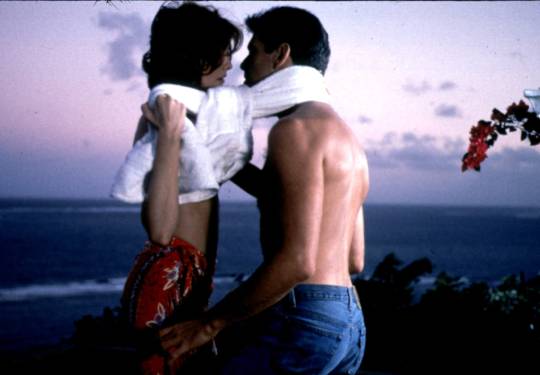
Banning is also led astray by Crown’s wealth and privilege--a tropey characteristic of female romantic leads all the way into the 21st Century. This would not be distracting except that it occurs during a sequence in the Caribbean island Martinique where the film’s pace otherwise grinds to a halt.
For reasons to be discussed, these appear to be problems with the script from its most early drafts. But The Thomas Crown Affair starts to circumvent romance tropes with its first shot. If there is a theme in The Thomas Crown Affair I have come to respect, it is the couple’s incongruent needs. Thomas Crown is attracted to Catherine Banning because of personal insecurity. On the other hand, Banning is attracted to Crown because he is handsome, receptive and fun to be with.
Crown’s insecurities regarding his love life are first stirred up in his first scene when his therapist questions in session whether a woman could ever trust him. In Crown’s relationship with Catherine Banning, he tries to prove that he trusts her as opposed to earning her trust.
From this context, Crown cannot resolve by himself his insecurity about whether a woman can trust. He is going about it wrong. What’s more, trust issues are only Crown’s hangup, not necessarily Banning’s.
Crown’s insecurity is not resolved at the end of the film. At a height of tension in their relationship, Crown promises Banning he will return the stolen Monet to prove that he trusts her. Instead she passes the information to the police.
This turn of events is perhaps the strength of The Thomas Crown Affair as a romance film. It is true that Banning sides with the police in part because of a misunderstanding about Crown’s relationship with another woman. This sort of misunderstanding is typical of Hollywood romance films.
On the other hand, the film avoids a more problematic romance trope by not stating whether Banning should choose Crown or the police. Romance films are typically coded so that a couple, especially the female-gendered half, should choose their romantic interest over their other values or responsibilities. But The Thomas Crown Affair does not even make the case that Banning should side with Crown over the police.

A climactic chase follows between Crown and the police inside the Met. Crown not only returns the painting while evading the police, he steals another--The Banks of the Seine at Argenteuil by Édouard Manet. The painting by Manet is what Banning points to on their first date, saying she would steal that one if given the choice.
Banning goes to the Wall Street Heliport where Crown asks her to meet him. But he has already left and his associate gives her the painting instead. A generous gesture, but Banning does not keep the painting. She returns it to the police instead.
In that entire sequence, Crown shows that he did not fully trust her. And Banning does not reciprocate Crown’s further doting on her.
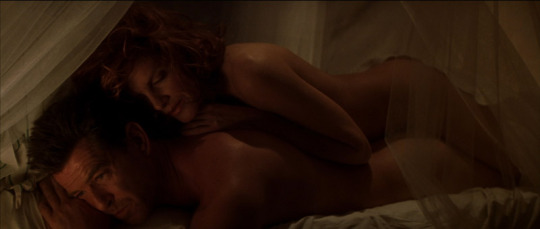
Catherine Banning’s attraction to Crown is based less on her emotional needs than for the thrill. As Crown says on their first date, “You like the chase.” This aspect is consistent with Banning’s counterpart in the 1968 film, Vicki Anderson as played by Faye Dunaway.
However, one of the major deviations between the 1999 movie and the original 1968 The Thomas Crown Affair is the remake’s “happy” ending. Crown arranges to sit behind Banning on her flight back to Europe and draws her attention by speaking in a Scottish accent.
The scene is ambiguous as to the couple’s future. The fact that Crown speaks in a Scottish brogue for his last line is a callback to the couple’s first date, when he says the hardest part of attending Oxford University was “learning to talk.” Crown finally feels free of the pretensions of English and American culture.
At the same time, Crown and Banning’s needs in the relationship are so different that it is foreseeable they are not a long term match.
As a film romance, The Thomas Crown Affair is refreshing because its romantic leads are not necessarily perfect for each other. They have their own motivations that are never completely reconciled or resolved. And that is more true to life than most Hollywood romances.
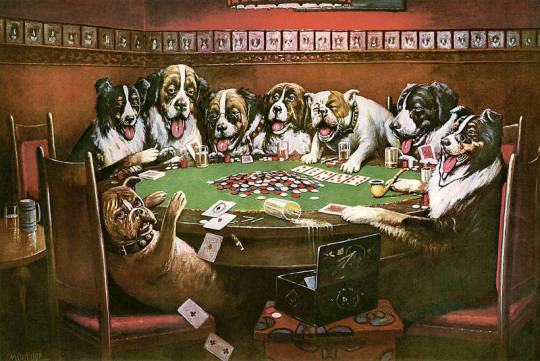
The Thomas Crown Affair’s script is written with a curious indifference to materialism. In today’s world, its tone may come off as dissonant. But understanding its perspective requires consideration of not only the era when it was written but the people involved in making the film.
The Thomas Crown Affair was one of the first films produced by Irish DreamTime, a production company founded by Pierce Brosnan and Producer Beau Sinclair. By the time a Director was signed, at least one version of the script was already being drafted. The best explanation why the film conforms to romantic comedy schlock is that its first draft was written to do so.
The early version of the script appears to have remained intact, since writing credits were still retained by Leslie Dixon and Kurt Wimmer. And since Pierce Brosnan was a producer, this means that The Thomas Crown Affair was intended as a vehicle for Brosnan. This is made apparent in the Martinique sequence, which is also where the film’s perspective on materialism is its most loud.
In the exact middle of the film, Crown takes a holiday with Catherine Banning in his island estate. As intimate and seductive as the setting is, Crown also advertises his lavish lifestyle to Banning. His seduction of Banning becomes more obvious when he offers her even more money than her commission to run away with him.
This sequence was likely included at the behest of Actor-Producer Brosnan himself. The actor has a well known attraction to tropical locales and even maintains a home in the Hawaiian Islands today. The ambiguities regarding Crown’s criminality or immorality would then be the product of indifference by the Writers and production staff.

This part of the film stands out in the 21st Century because of several scandalous stories involving Caribbean criminal havens, including the Paradise Papers and Jeffrey Epstein’s estate on Little Saint James in the U.S. Virgin Islands.
Obviously these scandals were not in the mind of the Producers when the movie was shot in the late 1990s.
But Thomas Crown is also represented ambiguously throughout the film. He is a remorseless criminal who has his hands dirtied by other schemes--bribery and offshore banking. This is consistent with the original 1968 film where Crown was more a villain than antihero. But more than the 1968 film, Thomas Crown is humanized as a protagonist and romantic lead. By association his values are also normalized.
Director John McTiernan’s similarities to Thomas Crown make the film’s perspective on materialism and white collar crime suspicious. McTiernan did more than direct. He also (uncredited) rewrote the script and used his own property and vehicles in the film.
McTiernan’s biography is also suspect. In 2000 McTiernan wiretapped a film Producer and later lied to Federal Investigators twice. Prosecution would drag until 2013 when McTiernan was finally sentenced to twelve months in prison.
During McTiernan’s first sentencing in 2006, the presiding judge publicly stated John McTiernan thought he was “above the law,” and “lived a privileged life and simply wanted to continue.”
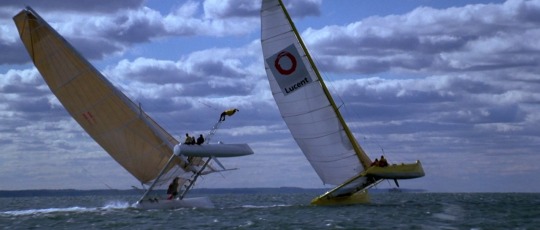
There is reason to believe that McTiernan based Thomas Crown on himself during his rewrite. Thomas Crown is shown not to be attracted to fame or a cushy lifestyle. Instead, he is a thrill-seeker with a death wish.
But Crown’s motives are never stated explicitly in The Thomas Crown Affair. Furthermore, they are muddied by the existence of a forged Monet in Crown’s possession. The forged painting is eventually discovered by Catherine Banning. Although Crown needed the real Monet to commission the forged Monet, we learn by the end that Crown no longer had the stolen painting when he first met Banning.
Although the forged Monet tricks Banning, this could not have been Crown’s intent when he commissioned it. The best explanation is that Crown intended to trick the police.
More than that, it means Crown committed his theft intent on being found out. This is curiously similar to the judge’s description of Director John McTiernan--that he thought he was “above the law.” McTiernan’s detachment from the consequences of lying to Federal Investigators twice also echoes Crown’s arrogant disrespect for the police.
There are also sociological reasons The Thomas Crown Affair is ambivalent about wealth and materialism. Public opinion about Wall Street and the U.S. financial industry was not as negative in 1999 as it is in 2021. This is partly a result of politics changing in response to current events.
At the same time, the Wall Street boom of the 1980s and how it changed New York City were still fresh in the public consciousness of 1999. Especially in 1999, where big business was not yet politically divisive prior to the Dot-Com Bust.

The indifference the public had for big business is embodied by Detective McCann. By the end of the movie, although Thomas Crown has outsmarted the police and museum security, McCann admits to Catherine Banning that he does not really care about catching Crown.
McCann implies that compared to cases of domestic violence and human exploitation he usually investigates, the art heist by Crown is a victimless crime. The stolen paintings only matter to “very silly rich people.”
Detective McCann is held up throughout the film as its moral center. He has legitimate care and respect for Catherine Banning--even though it is shamelessly teased as a love triangle. He is motivated to solve the case from a sense of professional responsibility. In his last scene Banning even tells him, “You’re a good man, Michael.”
But McCann’s indifference to Crown’s crimes is The Thomas Crown Affair’s moral failure. The victims of art theft are not just the owners but the public itself. Pop culture pre-Enron was similarly indifferent about fraud and white collar crime, believing the victims were only the rich and wealthy.
This indifference is a product of the era. The world would learn very shortly that costs of financial fraud and white collar crime are felt more by society than by the financial industry itself. But to Hollywood and audiences in 1999, Thomas Crown’s art theft and financial crimes were all victimless crimes.

An aspect of The Thomas Crown Affair that deserves credit is its representation of New York City. The city depicted in the film is different from the experiences of most New Yorkers, even in 1999.
Although the film is not always shot in the correct location, the city is represented well in spirit. Early in the movie, a truck driver making a delivery to the Met gripes when Thomas Crown crosses into his lane. Detective McCann similarly expresses contempt for New York City’s social circuit in a manner often overhears. “I love this neighborhood, some of these broads are wearing my salary.”
An AIDS Research Ball hosted by BVLGARI is another realistic part of New York City culture in that AIDS activism had become mainstream by the late 1990s.
The Thomas Crown Affair is shot in a part of New York City that is inaccessible to most people, yet widely advertised. And it is represented in film authentically and amorally--if for no other reason than because the film was shot almost entirely within the city.
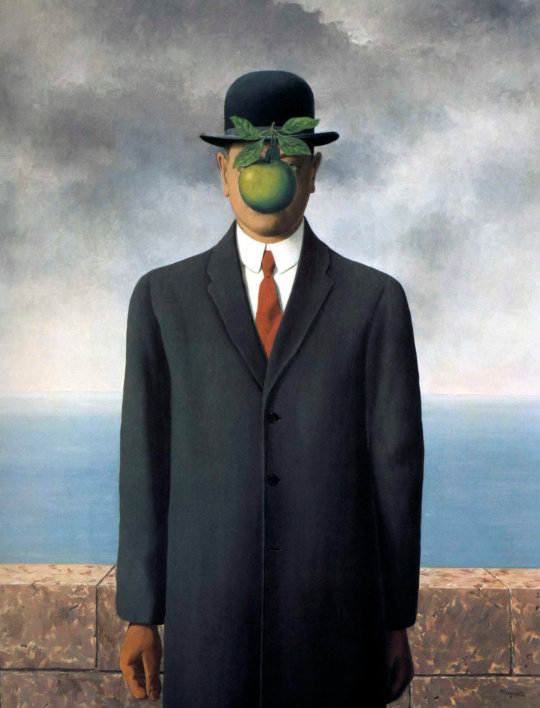
Perhaps the most widely entertaining aspect of The Thomas Crown Affair is its contribution to the heist film genre. Heist films are different from other crime movies in that the narrative usually follows the criminal’s or robber’s perspective.
Heist films are also preoccupied with how the criminal will pull off the caper. They differ from detective films where catching and identifying the criminal are the lingering mysteries.
But The Thomas Crown Affair is different from other heist movies in that the finer details of Thomas Crown’s capers are never shared with the audience. For instance, when Crown steals the Monet we are left to wonder how he evaded museum surveillance. Catherine Banning offers an explanation, but the question is never answered for certain.
Another mystery lingers when Thomas Crown steals the Manet at the end of the film. Absolutely no hints are offered as to how he managed to steal it. Part of the attraction of films like these is they leave audiences to guess how certain events occurred.
My favorite explanation for the stolen Manet is that Crown had a mole working at the Met steal the painting beforehand. That also explains how Crown obtained the information necessary to steal the first painting.
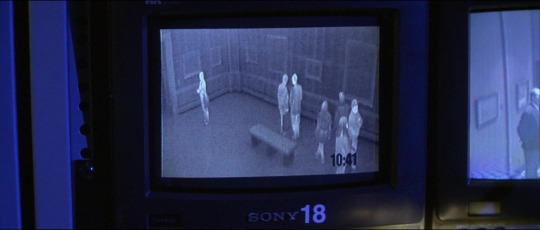
Catherine Banning’s explanation for why museum security failed to capture the first theft is that a heater was left in front of the painting. That is because museum surveillance used infrared cameras that responded to temperature, and a heater would have been just enough to interfere with the infrared camera. I should mention now that this feature of museum surveillance is one of the more far-fetched details in The Thomas Crown Affair. Especially today, since face recognition software is in such demand in cyber security.
Lack of realism in films about art or jewel theft is common within the genre, and especially true of the era’s other films--Mission: Impossible, Entrapment and Ocean’s Eleven.
The purpose of heist movies like this is wonder more than realism. And prior films have been similarly tongue-in-cheek about painting and jewel theft--such including the Blake Edwards comedy The Pink Panther.
Films like The Thomas Crown Affair are not intended to be a blueprint for future criminals. Ironically, The Thomas Crown Affair did inspire one bank robber who got away with the loot using the same costumed diversionary tactic as Thomas Crown in the film’s climactic chase scene.
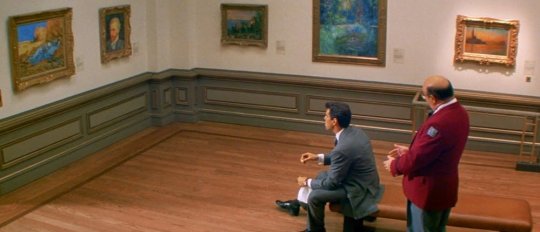
Even though I have said a lot about The Thomas Crown Affair, there are simple reasons why I am fond of the movie. It is a well-made movie, beautifully shot and secretly intelligent. It is a decent representation of New York City, despite complications in the script and budget.
The movie itself is light and entertaining and leaves it up to the viewer to make up their mind. Yes, it requires some suspension of disbelief. Yet even in that way, it treats its audience as mature adults. A quality rare in action or romantic films of any era.
-ve
NEXT POST--#8 LET THE BULLETS FLY (dir. Jiang Wen)
#the metropolitan museum of art#New York City#pierce brosnan#john mctiernan#thomas crown affair#rene russo#martinique#art#impressionism#claudemonet#edouard manet#vincent van gogh#haystack#san giorgio maggiore#denis leary#surveilance#heist film#aids activism#1990s films#cipriani#magritte#white collar crime#romance#romantic film#pissarro
15 notes
·
View notes
Link
Martin Gurri's The Revolt Of The Public is from 2014, which means you might as well read the Epic of Gilgamesh. It has a second-edition-update-chapter from 2017, which might as well be Beowulf. The book is about how social-media-connected masses are revolting against elites, but the revolt has moved forward so quickly that a lot of what Gurri considers wild speculation is now obvious fact. I picked up the book on its "accurately predicted the present moment" cred, but it predicted the present moment so accurately that it's barely worth reading anymore. It might as well just say "open your eyes and look around".
…
In conclusion, 2011 was a weird year.
Gurri argues all of this was connected, and all of it was a sharp break from what came before. These movements were essentially leaderless. Some had charismatic spokespeople, like Daphni Leef in Israel or Tahrir-Square-Facebook-page-admin Wael Ghonim in Egypt, but these people were at best the trigger that caused a viral movement to coalesce out of nothing. When Martin Luther King marched on Washington, he built an alliance of various civil rights groups, unions, churches, and other large organizations who could turn out their members. He planned the agenda, got funding, ran through an official program of speakers, met with politicians, told them the legislation they wanted, then went home. The protests of 2011 were nothing like that. They were just a bunch of people who read about protests on Twitter and decided to show up.
Also, they were mostly well-off. Gurri hammers this in again and again. Daphni Leef had just graduated from film school, hardly the sort of thing that puts her among the wretched of the earth. All of these movements were mostly their respective countries' upper-middle classes; well-connected, web-savvy during an age when that meant something. Mostly young, mostly university-educated, mostly part of their countries' most privileged ethnic groups. Not the kind of people you usually see taking to the streets or building tent cities.
Some of the protests were more socialist and anarchist than others, but none were successfully captured by establishment strains of Marxism or existing movements. Many successfully combined conservative and liberal elements. Gurri calls them nihilists. They believed that the existing order was entirely rotten, that everyone involved was corrupt and irredeemable, and that some sort of apocalyptic transformation was needed. All existing institutions were illegitimate, everyone needed to be kicked out, that kind of thing. But so few specifics that socialists and reactionaries could march under the same banner, with no need to agree on anything besides "not this".
…
Gurri isn't shy about his contempt for this. Not only were these some of the most privileged people in their respective countries, but (despite the legitimately-sucky 2008 recession), they were living during a time of unprecedented plenty. In Spain, the previous forty years had seen the fall of a military dictatorship, its replacement with a liberal democracy, and a quintupling of GDP per capita from $6000 to $32000 a year - "in 2012, four years into the crisis there were more cell phones and cars per person in Spain than in the US". The indignado protesters in Spain had lived through the most peaceful period in Europe's history, an almost unprecedented economic boom, and had technologies and luxuries that previous generations could barely dream of. They had cradle-to-grave free health care, university educations, and they were near the top of their society's class pyramids. Yet they were convinced, utterly convinced, that this was the most fraudulent and oppressive government in the history of history, and constantly quoting from a manifesto called Time For Outrage!
So what's going on?
Our story begins (says Gurri) in the early 20th century, when governments, drunk on the power of industrialization, sought to remake Society in their own image. This was the age of High Modernism, with all of its planned cities and collective farms and so on. Philosopher-bureaucrat-scientist-dictator-manager-kings would lead the way to a new era of gleaming steel towers, where society was managed with the same ease as a gardener pruning a hedgerow.
…
Realistically this was all a sham. Alan Greenspan had no idea how to prevent recessions, scientific progress was slowing down, poverty remained as troubling as ever, and 50% of public school students stubbornly stayed below average. But the media trusted the government, the people trusted the media, and failures got swept under the rug by genteel agreement among friendly elites, while the occasional successes were trumpeted from the rooftops.
There was a very interesting section on JFK’s failure at the Bay of Pigs. Kennedy tried to invade Cuba, but the invasion failed very badly, further cementing Castro’s power and pushing him further into the Soviet camp. Representatives of the media met with Kennedy, Kennedy was very nice to them, and they all agreed to push a line of “look, it’s his first time invading a foreign country, he tried his hardest, give him a break.” This seems to have successfully influenced the American public, so much so that Kennedy’s approval rating increased five points, to 83%, after the debacle!
…
In Gurri's telling, High Modernism had always been a failure, but the government-media-academia elite axis had been strong enough to conceal it from the public. Starting in the early 2000s, that axis broke down. People could have lowered their expectations, but in the real world that wasn't how things went. Instead of losing faith in the power of government to work miracles, people believed that government could and should be working miracles, but that the specific people in power at the time were too corrupt and stupid to press the "CAUSE MIRACLE" button which they definitely had and which definitely would have worked. And so the outrage, the protests - kick these losers out of power, and replace them with anybody who had the common decency to press the miracle button!
…
Any system that hasn't solved every problem is illegitimate. Solving problems is easy and just requires pressing the "CAUSE MIRACLE" button. Thus the protests. In 2011, enough dry tinder of anger had built up that everywhere in the world erupted into protest simultaneously, all claiming their respective governments were illegitimate. These protests were necessarily vague and leaderless, because any protest-leader would fall victim to the same crisis of authority and legitimacy that national leaders were suffering from. Any attempt to make specific demands would be pilloried because those specific demands wouldn't unilaterally end homelessness or racism or inequality or whatever else. The only stable state was a sort of omni-nihilism that refused to endorse anything.
(I’m reminded of Tanner Greer’s claim that the great question of modernity is not “what can I accomplish?” or “how do I succeed?” but rather “how do I get management to take my side?”)
Gurri calls our current government a kind of "zombie democracy". The institutions of the 20th century - legislatures, universities, newspapers - continue to exist. But they are hollow shells, stripped of all legitimacy. Nobody likes or trusts them. They lurch forward, mimicking the motions they took in life, but no longer able to change or make plans or accomplish new things.
…
How do we escape this equilibrium? Gurri isn't sure. His 2017 afterword says he thinks we're even more in it now than we were in 2014. But he has two suggestions.
First, cultivate your garden. We got into this mess by believing the government could solve every problem. We're learning it can''t. We're not going to get legitimate institutions again until we unwind the overly high expectations produced by High Modernism, and the best way to do that is to stop expecting government to solve all your problems. So cultivate your garden. If you're concerned about obesity, go on a diet, or volunteer at a local urban vegetable garden, or organize a Fun Run in your community, do anything other than start a protest telling the government to end obesity. This is an interesting contrast to eg Just Giving, which I interpret as having the opposite model - if you want to fight obesity, you should work through the democratic system by petitioning the government to do something; trying to figure out a way to fight it on your own would be an undemocratic exercise of raw power. Gurri is recommending that we tear that way of thinking up at the root.
Second, start looking for a new set of elites who can achieve legitimacy. These will have to be genuinely decent and humble people - Gurri gives the example of George Washington. They won't claim to be able to solve everything. They won't claim the scientific-administrative mantle of High Modernism. They'll just be good honorable people who will try to govern wisely for the common good. Haha, yeah right.
…
Gurri divides the world between the Center and the Border. He thinks the Center - politicians, experts, journalists, officials - will be in a constant retreat, and the Border - bloggers, protesters, and randos - on a constant advance. His thesis got a boost when Brexit and Trump - both Border positions - crushed and embarrassed their respective Centers. But since then I'm not sure things have been so clear. The blogosphere is in retreat (maybe Substack is reversing this?), but the biggest and most mainstream of mainstream news organizations, like the New York Times are becoming more trusted and certainly more profitable. The new President of the US is a boring moderate career politician. The public cheers on elite censorship of social media. There haven't been many big viral protests lately except Black Lives Matter and the 1/6 insurrection, and both seemed to have a perfectly serviceable set of specific demands (defunding the police, decertifying the elections). Maybe I've just grown used to it, but it doesn't really feel like a world where a tiny remnant of elites are being attacked on all sides by a giant mob of entitled nihilists.
…
At the risk of being premature or missing Gurri's point, I want to try telling a story of how the revolt of the public and the crisis of legitimacy at least partially stalled.
Gurri talks a lot about Center and Border, but barely even mentions Left and Right. Once you reintroduce these, you have a solution to nihilism. The Left can come up with a laundry list of High Modernist plans that they think would solve all their problems, and the Right can do the same. Then one or the other takes control of government, gets thwarted by checks/balances/Mitch McConnell, and nothing happens. No American Democrat was forced to conclude that just because Obama couldn't solve all their problems, the promise of High Modernism was a lie. They just concluded that Obama could have solved all their problems, but the damn Republicans filibustered the bill. Likewise, the Republicans can imagine that Donald Trump would have made America great again if the media and elites and Deep State hadn't been blocking him at every turn. Donald Trump himself tells them this is true!
With this solution in place, you can rebuild trust in institutions. If you're a Republican, Fox News is trustworthy because it tells you the ways Democrats are bad. Some people say it's biased or inaccurate, but those people are Democrats or soft-on-Democrat RINO traitors. And if you're a Democrat, academic experts are completely trustworthy, and if someone challenges them you already know those challenges must be vile Republican lies. Lack of access to opposing views has been replaced with lack of tolerance for opposing views. And so instead of the public having to hate all elites, any given member of the public only needs to hate half of the elites.
You could think of this as a mere refinement of Gurri. But it points at a deeper critique. Suppose that US left institutions are able to maintain legitimacy, because US leftists trust them as fellow warriors in the battle against rightism (and vice versa). Why couldn't one make the same argument about the old American institutions? People liked and trusted the President and Walter Cronkite and all the other bipartisan elites because they were American, and fellow warriors in the battle against Communism or terrorism or poverty or Saddam or whatever. If this is true, the change stops looking like the masses suddenly losing faith in the elites and revolting, and more like a stable system of the unified American masses trusting the unified American elites, fissioning into two stable systems of the unified (right/left) masses trusting the unified (right/left) elites. Why did the optimal stable ingroup size change from nation-sized to political-tribe-sized?
…
The one exception to my disrecommendation is that you might enjoy the book as a physical object. The cover, text, and photographs are exceptionally beautiful; the cover image - of some sort of classical-goddess-looking person (possibly Democracy? I expect if I were more cultured I would know this) holding a cell phone - is spectacularly well done. I understand that Gurri self-published the first edition, and that this second edition is from not-quite-traditional publisher Stripe Press. I appreciate the kabbalistic implications of a book on the effects of democratization of information flow making it big after getting self-published, and I appreciate the irony of a book about the increasing instability of history getting left behind by events within a few years. So buy this beautiful book to put on your coffee table, but don't worry about the content - you are already living in it.
2 notes
·
View notes
Text
My Spier & Mackay Custom Shirt Guide
If you’re looking into having a custom shirt made through Spier & Mackay, I recommend them. Of the online custom shirt makers I’ve tried, they have my favorite pattern. Something about the way they cut the armholes and chest is magic—fitted but not constricting.
The process is pretty straightforward, but it can nonetheless be daunting because the pressure to get it perfect on the first go is high. I’ve ordered a few shirts at this point, and have some tips for getting the best results.

Fit considerations
Measuring
I prefer to measure shirts I like the fit of and combine those measurements into the ideal amalgamation of them all. That gives maximum control over the resulting fit pattern. Below are some tips to make sure you get it right.
Pay attention to their specific instructions for how to measure by watching the embedded YouTube videos for how to do it. In particular:
Neck measurement is measured from the button to the middle of the buttonhole, not the far end of the buttonhole (like some other shirt makers).
Cuff is measured end to end, not button to buttonhole (this is huge; don’t mess this up).
The sleeve measurement is straightforward, but many people have a misconception about how long a shirt sleeve should be. A sleeve should hang about an inch past your wrist when the cuff’s unbuttoned (and your cuff should be cut slim enough that when it’s buttoned, your hand stops the cuff from slipping down). Watch the video of how to measure your body for a shirt and that illustrates where it should go. When you’re inputting your own shirt measurements, adjust accordingly.
The armhole measurement is tricky to figure out. You measure a shirt by laying it flat but that makes the armhole curve a little. The instructions say to measure straight, though. So here’s how to think of what you’re doing to alleviate confusion: Measure the full length of the seam. You can either do that by leaving it curved and measuring around the curve, or pulling it straight and measuring it straight.
Speaking of armhole, my suggestion is to go for a relatively small armhole and relatively loose bicep. My first shirt had a high armhole and slim bicep and it feels constricting. My second shirt had a slightly more relaxed armhole and slim bicep, and it still felt a little constricting. I locked it in at a small armhole, with looser bicep, and it’s awesome. Great range of motion, comfortable, and wearable.
Elbows and forearms. I hate feeling like my shirt might tear at the elbow. But if you have a fairly fitted cuff and relatively fitted bicep (compared with the way many shirts are super loosely cut), that can happen. So I specified the elbow measurement in the comments of the shirt order. That measurement is simply measuring the sleeve from the end of the cuff to the shoulder seam, and right in the middle is where to measure the elbow. Measure it straight across the sleeve.
If you also want to specify the forearm, which might be unnecessary (I did it but if you specify the elbow it’ll probably work itself out), you measure 6 inches up from the cuff seam (where it attaches to the sleeve) and take the measurement straight across. Measure straight across the sleeve.
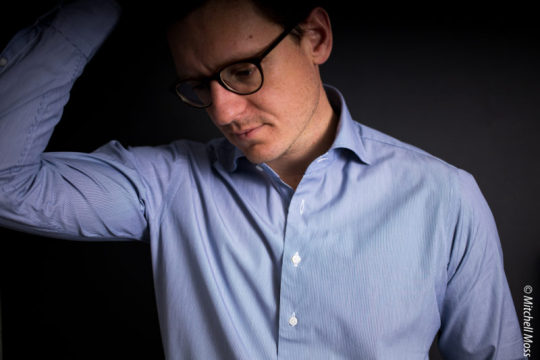
Do you have to allow for fabric shrinkage?
My experience has been that the shirts are cut accurately, and shrinkage has been minimal. I asked Rick, the owner of Spier & Mackay, and he confirmed that they cut with normal shrinkage allowance in mind, so you don’t have to game the system to get the result you want (which mirrors my experience so far). A few years ago, a couple fabrics they offered had major shrinkage, which got lots of chatter on Styleforum, but he tells me those fabrics were discontinued 2 years ago and it’s been a non-issue ever since.
What if the shirt comes out wrong? What’s the cost for a remake?
Remakes for fit problems that are your own making—say you don’t carefully read the instructions for cuff width (edge-to-edge, not button-to-buttonhole!) and they’re super tight—are half price. To initiate that process, just email their customer service at [email protected] to get the ball rolling. However, like any good company, if the shirt is cut wrong—say you specified a measurement and it comes out way off by more than a normal tolerance—they’ll make it right on their dime.

Design considerations
Collar choices are personal and many design choices are personal, too. But below are some of my preferences based on my own style and recommendations for design combinations based on what I’ve seen good designers do.
Button-downs
The button-down collars from Spier are rockin’. The classic one (C3-K) is really great for almost everyone. The Italian version they sometimes use off the rack for special makes (C22), like the washed denim shirts, is 10% extra cool and a little bigger, but not so noticeably bigger as to call more attention to itself. For those who want maximum collar drama, there’s the biggest Italian button-down (C23), which I plan to test eventually.
Design pairings with button-down collars
Pair button-down collars with the rounded single button cuff and normal placket. On the back, go for a center box pleat if you’re a traditionalist, but side pleats give it a modern twist that breathes a bit of life into the OCBD. Pocket or no is your choice. If it’s striped, specify “one piece yoke” in the comments.

Spread collars
I personally go for either large cutaways (which I like when worn without a tie the best), or large spread collars. So for me that’s the C21 and C19 collars. Big, tall collar band and big, long collar points, which tuck under a jacket nicely and stand tall. However, for someone with a smaller frame and/or shorter neck, the standard version of these collars would also work well (C13, C16, C17).
Design pairings with spread and cutaway collars
Pair these with either the rounded single button cuff or a mitered cuff (mitered is more business-y if that’s what you’re going for). For the placket, a French turn placket is the more business friendly approach; go standard placket for more casual fabrics like chambray or oxford cloth. And on the back, either side pleats or no pleats. I do no pocket, typically. One designer who makes a great shirt that dresses up or down excellently is Sid Mashburn who makes his with spread collars, a standard placket, rounded cuffs, side pleats and a front pocket in all types of fabrics, and it looks great in every situation.

Collar linings (and cuffs and placket, too)
Unusual for many custom shirt makers is the ability to specify collar, placket and cuff linings. Most of Spier’s shirts have a fused interlining of some sort by default but you can specify in the comments box during the checkout process for them to use something different. Here’s the down-low:
There are four levels of collar interlinings ranging from lightest to stiffest. The linings can be either simply sewn in, or fused into the collar, and you can even have them use two layers if you want.
From lightest to stiffest, the identifiers are soft, medium, medium-firm, and firm. My preferences are for the lighter linings, which allow the collar to roll and have some shape to them (which is an Italian affectation; you may prefer the collar to stay starched in place). Here is how I have done shirts so far, and I like it. I may experiment in the future but for now this has given me good results:
For shirts in more casual fabrics like oxford cloth or cotton-linen or madras, I go for a single layer medium sewn interlining. It gives the collar just enough body to shape nicely, but doesn’t weigh it down. Inside button-down collars, it gives the collar a perfect amount of body to roll beautifully, but is thin enough the collar still has some of the charming unlined look. This feels about like how a Drake’s Oxford collar feels to me.
For shirts in business-y fabrics like broadcloth or pinpoint oxford, I go for the single layer medium fused interlining. The fusing makes the collar smoother in appearance, so it’s a bit more professional. It still stands up well under a jacket without a tie on, too. This feels about like how my Eidos dress shirt collars feel to me.
Just remember to specify in the comments box no only the collar lining, but for clarity, also specify that you also want the same in the cuffs and placket if your shirt is being made with a placket. (They might do this automatically but I’m not sure so it’s safer just to put it in writing.)


Basically unlimited options
You can ask them to do almost anything in the comments section. I haven’t gone too far down the rabbit hole with minute changes, but I have specified changes to the base collar pattern. Specifically, I’ve asked them to increase the front collar band height, and requested the collar be cut with no tie space. They accommodated both requests on my orders. (In case you’re wondering, I did that on the C21 collar, which modified it to be identical to my favorite Eidos shirt collar, the “Marcus”).
You can even send in a shirt you love and simply have them copy it, too. I haven’t done that, but if you want to give it a try, email [email protected] and they’ll tell you how to proceed.
So that’s it. Those are my tips for ordering a custom shirt from Spier & Mackay. While the program’s UI/UX on the website leaves a lot to be desired, and I still wish they’d allow you to order fabric swatches, the results and quality of the end product are excellent; and the price is outstanding.
Is there anything else you’d like to see covered in this article? Let me know in the comments below!
(Help support this site! If you buy stuff through my links, your clicks and purchases earn me a commission from many of the retailers I feature, and it helps me sustain this site—as well as my menswear habit ;-) Thanks!)
If you’re just getting into tailored menswear and want a single helpful guide to building a trend-proof wardrobe, buy my eBook. It’s only $5 and covers wardrobe essentials for any guy who wants to look cool, feel cool and make a good impression. Formatted for your phone or computer/iPad so it’s not annoying to read, and it’s full of pretty pictures, not just boring prose. Buy it here.



Read more at Menswear Musings
8 notes
·
View notes
Photo


This is something a bit different from me, but in light of the recent announcement from Ubisoft that there’s going to be a remake of Prince of Persia: Sands of Time coming out in January 2021, I thought I’d share some thoughts.
(This started out small but got outta hand so super long post incoming, no spoilers for the games)
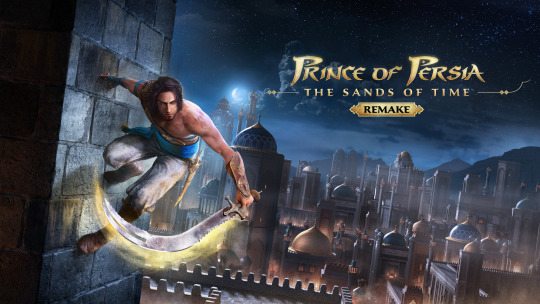
So first off, a bit of my history with the original game.
I’m a big fan of the Prince of Persia (PoP) franchise, and I’ll fully admit that nostalgia plays a big part in it. You see, in many ways this 2003 classic was my real entryway drug into the world of videogames.
It wasn’t the first videogame I had ever played. My friends had consoles, there were some games on the school computers, but I didn’t own games as a kid. As far as my parents were concerned, these were all the spoils and soul damning devices of Lucifer himself. You know how it is, every generation goes through this thing of blaming all the world’s problems on a new artform: rock and roll, comic books and then videogames.
So yeah, a gaming console or buying games for the home computer was a BIG NO-NO!
But of course, the more an authority figure says you can’t have something, the more you want and crave it. It was only a matter of time until the opportunity presented itself to me.
And then the day finally came.
It was just me and a couple of friends, going to this new magazine store near the school. And there it was: the dvd case that came with a gaming mag for like 5 euros if I remember correctly, stupid cheap for such a great game.
There was doubt, there was fear, there was anxiety. I didn’t know much about the game, only the old 1989 DOS Prince of Persia:


This had the same name but looked different. I was seduced immediately.
The case stared longingly at me:
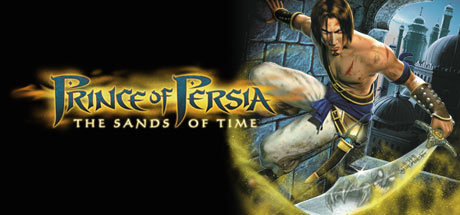
It’s not my fault, I was bewitched and I bought it.
My symbol of rebellion, my first big transgression, and my first real treasured posession that I bought with hard earned money.
PoP:The Sands of Time was my original sin so to say:
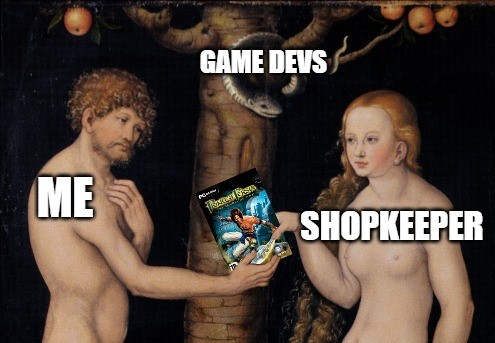
Accurate representation of what happened that day
I furiously installed the game as soon as my parents left the house. Played it for a couple of hours and stood in awe at the thing - the cinematics, the cool parkour moves, the arabian nights setting, the time manipulation to undo mistakes when platforming or in combat, the Prince breaking the fourth wall saying:”no no no, that’s not what happened, let me start over” whenever I died and got a game over…
You have not experienced true fear if at some point in your life you didn’t feel the cold sweat running down your back as you hear the very distinct sound of your parents’ car arriving when you’re doing something “prohibited”.
As soon as I heard that sound, I quickly quit the game, uninstaled it (I could not run the risk of them finding out I had tainted their machine with a videogame *gasp!*), and ran to my room to hide the game before opening the door for them.
Neetheless to say, I never made much progress since I had to start over every time after quitting and uninstalling the thing. I would just play those first couple of hours over and over, never knowing how the story progressed, but I was happy all the same. At one point I knew every line of dialogue, every music cue, every sound effect of that beginning part. It would be some years before I got my first laptop and finally managed to complete it.
All of this to say that the game means a lot to me. Not just as a product or piece of entertainment. This wasn’t casually playing on someone’s gameboy advance or PS2 to have a bit of fun and pass the time.
This was more intimate.
It was just me; the game; a dark room and a blanket; and a sincere and charming, simple but compelling story told seamlessly through mechanics that only enhanced it. This was me witnessing gameplay and storytelling going hand in hand in a way that even many of my other favourite games don’t do, or don’t do as well (there’s usually some disconnect where a game only manages to really excel at one but not the other).
Ok, so on the announcement and trailer:
youtube
As a big fan you might think I was super hyped for this.
But I gotta say…no, not really.
I’m not super angry, but I’m not really excited either honestly. And I don’t think it’s just the rough and uncanny character models and animation that people are pointing out all over (although that doesn’t help).
I guess to talk a bit on that, I should stress out that my problem isn’t that it doesn’t look realistic enough. To be honest, and this is going to sound rich from a big Witcher 3 fan, I think that the gaming industry overall, moreso big tripple A titles, seem to have this unhealthy obsession with photorealism. Like, I don’t need to see the characters’s pores to care about these polygon people. Strong art direction is what I feel is more valuable. I just don’t think this arms race to photorealism is sustainable. Games are taking longer to make and fund, and I’d rather have dev teams spend more time polishing and refining the games’ mechanics and/or story if the trade-off is less “realistic” graphics.
It might just be personal preference, but I wish we were getting more stylized character and world design. Go look at some screenshots for Pathologic 2, a game that came out last year that hits that sweet spot between full-blown cartoony/caricature and realistic by today’s standards:

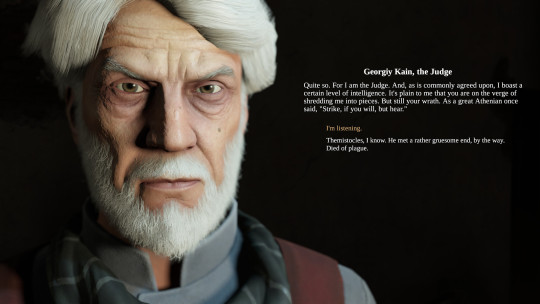
And I think that is somewhat what they were going for with this remake’s character models (or I hope it was). But it’s still not quite there, hopefully they’ll work on improving those so they can hit that sweet spot also.
(in defense of my hipocrisy and love of The Witcher 3, I think the more realistic look was appropriate for the world they were portraying, it benefits from it. However I don’t think I would love it any less if it had less detailed models and environments)
One last thing on the graphics.
I will say this though, at least from the footage we see in the new trailer the team seems to be capitalizing on colour. Big vibrant reds, blues, whites and yellows in the environment look great, and really captures the 1.001 nights/arabian nights feel that I absolutely love. I appreciate that since there’s always this tendency for remakes to suck all the colour and life from the original (in both games and movies), regardless if it fits the setting and tone or not.
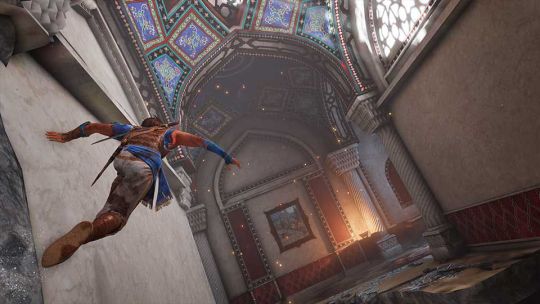
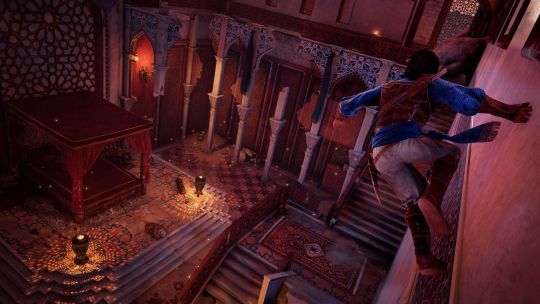
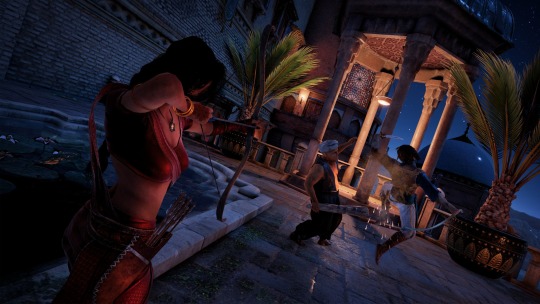
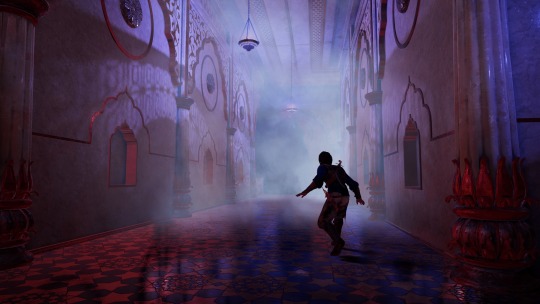
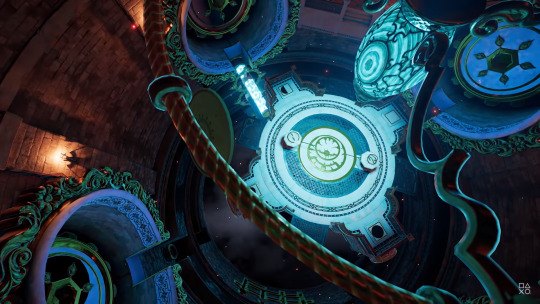
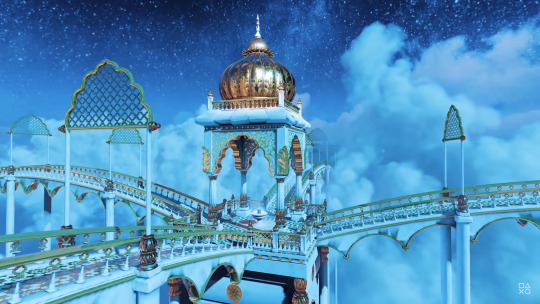
Anyway, I think the reason I’m very much without a big reaction is that I believe the 2003 original is a true classic, a masterpiece even - I guess I should stress out that when I say masterpiece, I don’t mean it’s perfect. Just that the whole is bigger and better than the sum of its parts, that the things it does right, it does so right, that it completely overshadows the flaws.
The story, the art direction, the gameplay (the holy trinity of platforming, combat and puzzle solving), the brilliant introduction of the dagger of time as a gameplay and story mechanic (one of my favourite mechanics in all of gaming), the music, the charming duo that is the Prince and Farah, the tight pacing with the game being just the right length and not overstaying its welcome, the outstanding level design where you’re never stuck doing one thing for too long (the game is always juggling between combat, story, platforming and puzzles, mixing and matching)…
Looking at all these things, I just really don’t think we need a remake because I don’t think there’s that many glaring terrible flaws that could justify it.
Adding more scenes and content could be good, or it might backfire: bloat and ruin the game’s already excelent pacing and fluidity (which I think is the main keyword that better describes the original, everything flows superbly). The original was only 6-8 hours long and it is better for it. I’m not confident that adding dozens of hours of gameplay like the big tittles today would help at all.
The only real improvements I can see are:
tweeking and perfecting the combat (I’ve seen it mentioned that they’re implementing a targeting system which sounds good);
perhaps also better Farah’s A.I during combat when you have to help protect her from swarms of enemies;
Maybe throw in a couple more enemy types? The cut sand tigers for example?
usual things like adding the option of subtitles, add the ability to skip cutescenes;
But other than that…
I don’t even think the graphics of the original look bad. They’ve aged of course, with the game being 17 years old, but still. I installed it last night and played through the first hour to take some screenshots and I think they’re still good:




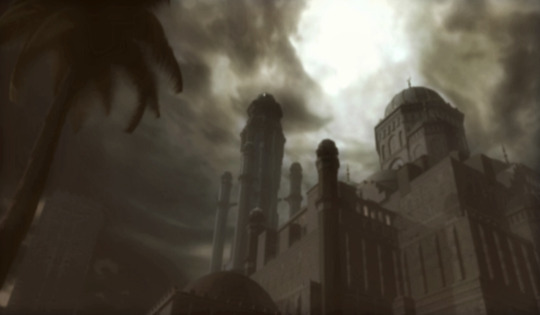

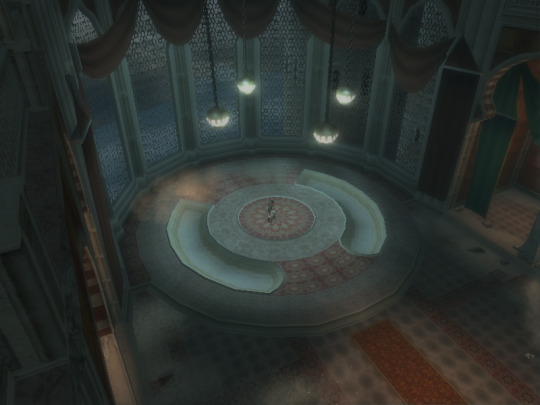
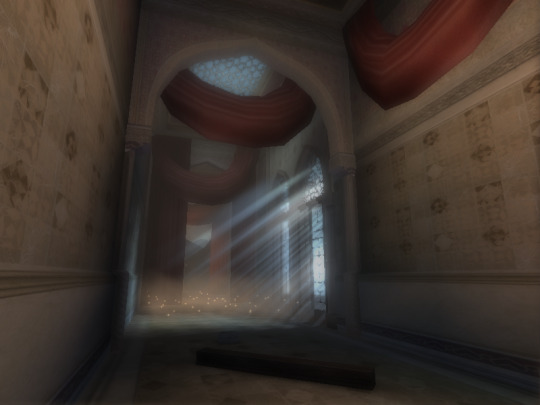




I can understand the MediEvil remaster, the Spyro remaster or the more recent FFVII remake in terms of wanting to update the graphics. I can understand that not everyone can easily go back to these low poly lads:

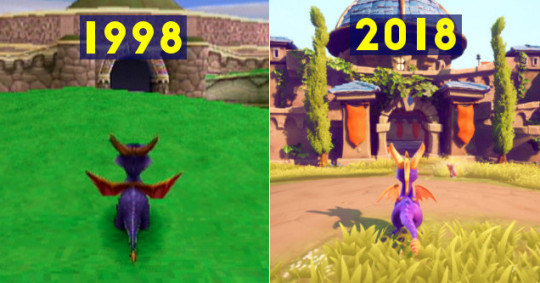
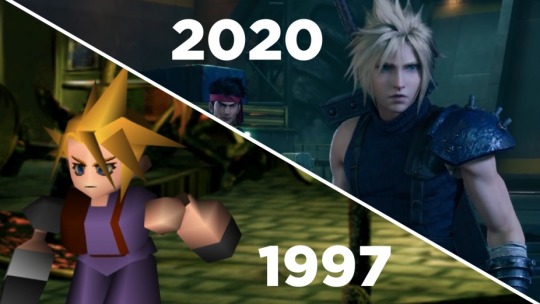
But this game? I know I’m influenced by nostalgia and all, but I don’t think it needs that makeover that badly, especially when compared to these other remakes and remasters. Funnily enough, I just noticed that these examples I just listed were all PS1 games. PoP: SoT was a PS2 , PC and Xbox game. PS2 era games have aged far better visually and don’t need that big a makeover in my most humble opinion.
It would be one thing if the original was out of print like a Rule of Rose scenario ,where you can’t find the game unless you go to ebay or something and it’s stupid expensive. Or if it was a pain to get running on modern systems like it was with Grim Fandango, until it got a remaster.
But no, you can find the Sands of Time trilogy and the PoP (2008) reboot on GOG and Steam (on Steam only there’s also the PoP:The Forgotten Sands midquel). So there isn’t the usual problem of the game no longer being accessible to people who want to play it, which helps justify the need for a remake.
The original still plays nice, sounds nice and looks nice, so I guess this all goes to show that at the end of the day, this remake just feels a bit unnecessary to me, at least from what little the trailer showed (I would love to have my bitter cynical ass proved wrong though!).
Maybe I just have a superhuman tolerance for older games and how they look, I really don’t have that big a problem if the game itself is good or interesting, so I don’t always think older games need remakes.
Maybe my falling out of love with Ubisoft in this last decade has curbed forever any hype I might have for their announcements, even when they pull out my son, my baby boy Prince of Persia out again.
Maybe I’m just burnt out and too pessimistic about remakes, remasters and adaptations (although game remakes usually do better than film ones).
And this makes me a bit sad because I don’t want to sh*t all over the first piece of “new” Prince of Persia content we’ve had since 2010??? Oof, it’s been a while.
Especially knowing that Yuri Lowenthal is coming back and excited to voice the Prince again. And I also don’t want to be too harsh since we’re looking at an alpha of the game. But so far I’m just very numb to this, I do seriously hope it turns out good and that they don’t rush it out the door. But I’m not convinced we need a remake in the first place. The original is a milestone, a game changer. I’d rather see a game that had great ideas and poor execution being remade than something people already love and consider a masterpiece.
Guess we’ll see how I feel once more news and footage come out.
Oh and feel free to share your own thoughts on this remake. I’m curious to know what both fans and newcomers alike think.
small edit: I can’t believe I was just watching this Sands of Time playthrough on youtube and at one point it is said: “Another game that is designed similarly to this is Soul Reaver actually.”
Of course! I didn’t even see it! All of my favourite things are connected!!! Maybe that detail was another thing that helped me getting really into Soul Reaver as I was first playing it.
#prince of persia#prince of persia: the sands of time#prince of persia remake#ubisoft#videogames#my ramblings#I can't seem to write a short post to save my life!
22 notes
·
View notes
Text
A Babysitters Guide to Monster Hunting- A Randomfish Review
Did you like the remake of Ghostbusters where there were female Ghostbusters? Well then you’ll love the all female remake of Monster Squad...
Is that accurate? Kind of. It feels like that right from a main character who believes in monsters, a villain who wants to bring together an army of monsters and of course sometimes the most random of moments. Although it isn’t an actual remake and it is it’s own thing want to make that clear.
What’s the story? Kelly Ferguson (played by Tamara Smart) is the kid at school who is apparently tortured by the kids of the town because she apparently saw a monster in her room and everyone just calls her “Monster Girl” oh and she skipped a grade because she’s smart, thanks to the exposition teacher (or maybe he’s the math teacher I forget)
Okay first thing to dissect is this..... WHY?! Why are the kids still torturing her about THAT? First off these are teenagers there would be plenty of gossip around town I’m fairly sure and secondly this doesn’t appear to be a massively small town so this type of thing wouldn’t be as well known as it is! There is the generic bully girl played by Anisa Harris who just picks on her coz she’s nerdy and weird but... again this feels very pointlessly generic... haven’t we evolved our bullies since then?
Kelly then gets’ guilt tripped to babysit her Mum’s boss’s kid because her Mum just assumed that she would be doing nothing ever and that she wouldn’t be trying to grow up and move on with her life like going to a party that was randomly announced in the hallway by some dude... I mean I can’t exactly say that’s it’s a bad scene either just convenient and to be honest if we sinned movies for being convenient then we’d just hate all movies (right CinemaSins?) and that the dude that is clearly the hot guy at school said he’d go and Kelly now wants to go in order to impress him and steal him away from Anisa Harris (yes the character has a name but she is so bland and forgettable why should I remember that character’s name?) but she goes to the boss’s house to babysit the kid named Jacob Zellman (Wow, I’m starting wonder if his mother is anyway related to Zelda or Hilda Spellman and just changed their names out of embarrassment) with the mother leaving behind a massive set of insane rules. However we learn that Jacob sees monsters just like Kelly did and while Kelly didn’t end up being taken by the monsters Jacob definitely does... okay now with the designs of the “Toadies” as they’re called in the film that’s not bad... what makes me laugh however with the rise of the villain of the film called Grand Guignol played by Tom Felton (yes THAT Tom Felton as if there’s any other) being a leader of some kind of boogiemen type of monster I began to wonder if we were about to get a modern take on the song “Dance Magic Dance” all of a sudden.
We then get introduced to the films’ resident badass on a scooter (not a motorbike because that doesn’t equate badass anymore apparently) who is Liz played by Oona Laurence who turns up with all the information and starts essentially dumping exposition on us! From names of monsters to the book that she has to read to understand everything about the monsters and all of this completely cavalier while carrying a baby on her back. After chasing down one of the toadies they bring it back to their headquarters where we actually get an idea why the film is called this; A Babysitters Guide to Monster Hunting where we learn that apparently this organization has existed for hundreds of years. We see pretty quickly that the writer of the book also wrote the screenplay as he just says things while assuming that the people who’ve read the book are watching and everyone else be damned.... well I am part of everyone else and I say “No! You be damned for once!” We then meet our resident variety of side characters who will do next to nothing; Fat Kid (I mean Curtis Critter played by Ty Consiglio), Cassie Zhen (played by Lynn Masako Cheng) and Berna Vincent (played by Troy Leigh-Ann Johnson) I say their names and characters now because to be honest they do a little behind the scenes stuff and try to give themselves focus but the crux of the whole thing rests on Kelly and Liz (who if you couldn’t tell from the attitude and the “hog” has a dark backstory) so they go off to get Jacob back who is being forced to bring his dreams to life which is why Draco Felton was trying to get him and why he was trying to get Kelly all those years ago too (yeah, that was a thing apparently Draco Felton has been stalking kids for years, there there’s an image in your fangirl minds about Draco Malfoy stalking kids) and so they go off to try and get a creature that can help them get the pieces together to take on and destroy Draco Felton and so they go to.... any guesses anyone? Yes you are correct madam it was the party that Kelly wanted to go to! They go there, words are exchanged, the boy that Kelly likes is confused but impressed I guess with the way she is as herself, generic bully is put in her place by Liz and, despite her saying that she wouldn’t go to the party while she was supposed to be babysitting Jacob there are videos on Instagram of her jumping off of a higher floor in someone’s home... that’ll look great Kelly well done also you wanna relax after jumping down a floor and landing on your face? No? Okay what do I know? They collect what they need and the nerd crew at the base (told you I’d forget their names they’re so forgettable those.... who?) make a device that Kelly can use to essentially punch Draco Felton to death (PUNCHING PEOPLE: As long as it’s monsters, it’s okay) they travel to a cat monster type person who traps them, LIz gets taken away by Felton and Kelly, who has been shockingly okay with this whole ordeal just gets up and heads for the lair on Liz’s scooter (sure she wont’ mind, at least fill up the tank you greedy whatsit) where we had learnt previously that Liz lost her brother to Draco Felton (see? Dark backstory) and he had hypnotized her with his lullaby even though we were shown that NEVER HAPPENING until we got to Liz so SCREW YOU MOVIE! Kelly snaps her out of it, they punch Draco Felton to death, Jacob is reunited with his mum just in time (Ferris Bueller would be proud) and Kelly begins her initiation into the Babysitters club and the ending is her looking at a book one of Draco Felton’s relatives, not going to the movies with a boy (because girl gotta save the world yo) and she’s feeling happy about this life of danger and madness she must now lead..... obviously this is baiting for a sequel, will it get one? I dunno we got a sequel to the Kissing Booth for crying out loud, something that didn’t need to happen in the least yet it did!
So what did I think of it? Well it’s trying to be like the monster hunting, wise cracking monster kid movies of old, hence why I referenced monster squad but does that make it good? I mean the acting isn’t awful, Tom Felton does a pretty good job with that role and it did take me a while to realise it was him under the makeup. Tamara Smart and Oona Laurence were fine as leading ladies although Oona felt like she should have been older when playing this role, just to show the difference in age and to show what the life could do to you. As it stands it feels like when Molly Ringwald and Ally Sheedy meet in Breakfast club if they went hunting for Judd Nelson after he turned into a werewolf or something.
But with all of it being said, this film was funny in places, tried to offer a sense of scariness that needed to go a bit further with it’s ideas
I’d say a solid 7/10 (yes I do ratings)
Please like this and let me know if there’s anything you’d like me to review next
#a babysitters guide to monster hunting#netflix#tom felton#oona laurence#tamara smart#Randomfish Review
12 notes
·
View notes
Note
something fascinating from a sociological meta perspective about all these franchises going off the rails and ending bleakly is that it's in line with studios attempting to cash in on the modern nihilistic sense of humor. I saw someone describe it as "pop culture nihilism" and this feels so off-putting yet accurate, that instead of getting uplifting tales to make us feel and do better we get stories that only affirm that nothing we do will matter
we’ve always had stories like that. it’s just far more prevalent in the era of stories being gate-kept by corporations and/or producers from the one-percent. of course they prefer stories that emphasize nothing ever matters, because the last thing they want is change. or that’s the second-to-last thing they want, with the actual last thing being competition.
it’s not just grimdark nihilism, either. you can see it in rom-coms where a successful big-city character experiences small-town life and discovers that doing small-town things on a small-town budget is just so much more fulfilling than wearing the latest fashions, having access to all the newest broadway shows, international cuisines, amazing museums... oh, no, that can’t possibly compare to truck rallies and small-town bake sales.
while this is often gendered, with high-powered women forced to be a stand-in mother (or pretend wife) and discovering their previous material/physical success was a hollow substitute covering up their desperate need to be a wife and/or mother -- sometimes it shows up on the male side, too.
where the high-powered corporate guy gets hit on the head or caught in a time loop or whatever gimmick and wakes up to find himself married to his high school sweetheart, working long grueling hours in blue collar, with three kids and too many bills to pay. yet somehow the lesson isn’t ‘thank god I made the choice I did not to get my girlfriend pregnant at sixteen and have to marry’ but ‘wow life is so much more fulfilling when you have little to no money, work in a brutal blue collar job, and have no prospects of affording college for those three monsters’. (or alternately, his car breaks down in a small town and he’s forced to deal with the locals and discovers they’re so much more ‘real’ and ‘true’ than the slick city types he’s used to.)
death of the author and all that, but in this case we have to look at who bankrolls these stories (at least in the US) -- and they’re very much the top-five-percent, financially. which means the story that’s supposedly affirming these situations as the ‘best’ thing (and all the limitations that come with that: less/lower education, less/lower job prospects, less/lower cultural exposure) are basically saying: oh, you should pity the person with the full bank account who’s just jetted off to Paris, or eats at the best restaurants, or shops at all the best tailors, who has corporate meetings all day and broadway tickets at night, the poor things, their lives are so hollow and empty what-with not knowing what it’s like to live in a ‘real’ place with its ‘real’ values. feel good in your small town with your limited prospects and your never-ending bills, because at least you have a ‘real’ life unlike these people with none of your worries.
that’s a different kind of nihilism, but when you step back, you can see it’s just as bleak, in its own way. like stories that should be uplifting heroic sagas yet either end with nearly everyone (except the white people) dead or are gritty grimdark rise-to-the-top-only-to-get-stabbed -- there’s a common theme that trying to have more is gonna make you miserable and lonely (or dead, depending on the genre). and it’s all geared towards getting you to come away with the conclusion that those at the top are just miserable suffering bastards who have no friends other than their possessions and you’re so much better off not even trying. oh, those pitiful rich people.
although sometimes it’s also gendered in another direction -- looking at you, Avengers and The Witcher -- where the story sets up the cards in such a way that a female character cannot simultaneously be powerful and a mother. Or that trying for both dooms her in some way, although more often she’s forced to ‘sacrifice’ being a mother if she’s to gain that power. And then, of course, she views herself as an aberration or as broken, as if an inability to bear children renders a woman somehow monstrous. (it’s only one step removed from the true monstrosity, culturally, of a woman who refuses to have children, which is also on the story gatekeepers’ list of characters that must be punished for daring to step out of line.)
but all that said, we need to look at the stories that have staying power -- and a lot of the stories that come to mind, right now, just haven’t been around long enough to demonstrate whether they’ll become cultural touchstones.
whenever we talk about stories and the zeitgeist, I’m reminded of that avatar movie (the one with blue people) that was so lauded at the time for its technical stuff, that it’d stand up there with Titanic and It’s a Wonderful Life and whatever. But now (if it’s ever even mentioned) it’s mostly in terms of comparison of budget, or special effects. otherwise it was mostly seems a blip on the cultural radar, quickly forgotten, but you need that time and distance to see that it was barely a few ripples in the cultural ocean.
compared to films like, say, the first Star Wars movie. or Lord of the Rings -- book or movie. or any of Jane Austen’s books. all of those fundamentally do posit worlds in which change can happen, there can be happy endings where the bad guys are put in their place and the good guys (even the little ones) can eventually prevail. there’s a ton of others, across every genre, but it takes time to see that long-term impact.
which is to say, yes. over the past thirty years, there’s been a tremendous trend (especially in fantasy) to take a grimdark approach where nothing we do will ever matter and/or we shouldn’t try to do anything because it’s doomed to failure/misery. there’s tons of books and films and shows pushing that perspective. in the end, though, the stories that matter most, the ones whose lessons have the greatest impact, are those we go back to over multiple generations, remaking them, recasting them, revisiting them.
those are the time-tested stories that speak loudest, and I would not be surprised if --- like A New Hope or Lord of the Rings or Star Trek --- those stories, overall, are ones that argue the exact opposite of this flash-in-the-pan nihilism. that even the smallest can play a role, that change is not only possible but worth the fight, and that the arc of history does bend towards justice.
56 notes
·
View notes
Text
Welcome Back

I am a card carrying geek. I was that nerd in grade school, reading comics, watching anime, and larping with his friends during recess. I’ve always loved things like books and film, mostly because my ma had a penchant for the sci-fi and we would share in her hobbies. I’ve been a fan of Doctor Who since i was a wee lil’ Smokey and had a particular fondness for Max Headroom’s shenanigans. My chosen proclivities lend themselves to alternate universes, divergent timeless, and the interdenominational doppelganger or two. What i am trying to convey, here, is that i am not stranger to the revisit of a franchise. For me, rebooting an established work or expanding a loved lore is not a transgression. I am a fan of narrative. If you can tell a unique story, it really doesn’t even have to be that good, but something creativity and compelling, i am totally on board. This isn't as difficult a feat as you'd think considering how well Hollywood can adapt international films. The Ring and The Departed are effectively remakes of their original Asian fare and those films are spectacular. Nolan’s Dark Knight trilogy is the best example of this i can give. His deconstruction of the Batman mythos was one of the best cinematic and storytelling experiences I ever had. If you can take an established narrative, an established universe, and inject your own flavor into it, i am down for that, too. The Kelvin Star Trek timeline immediately comes to mind. Again, comic book guy, specifically a Spider-Man shill.
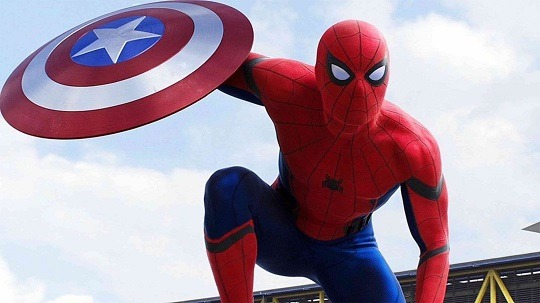
While i have years worth of alternate Spider-Men in the books to pull from, i think the most concise example i can give for a layman is to think Into the Spider-Verse, only with thousands more Spider-Men and Spider-Women. That’s the world I'm broaching this subject from, where there are decades worth of stories and reboots and remakes and reimagings, basically revisits, of a character that i absolutely love. Some are great like the Ultimate Spider-Man or the world of Renew Your Vows, and some are not so great, like that version Abrams’ kid came up with. That whole story was the worst. We have actually seen a little bit of this narrative reincarnation in the Spider-Man film franchise, itself, both good and bad. If we take the very first Spider-Man films, those campy, Raimi classics, as a starting point, then we had a terrible reboot in the Amazing franchise and a rather brilliant reimagining in the MCU outings. I really like the MCU retool. Tom Holland is THE onscreen Peter Parker and you can fight me about it all day.

Jurassic World and The Force Awakens are an interesting situation in the whole Revisit discourse. Both of these films are effectively reboots of the entire franchise and a whole ass remake of their initial entries. Beat for beat, theme for theme, these two films are basically the same as Jurassic Park and Episode IV, just less than they are in every conceivable fashion. Now, on paper, i should hate this but i don’t. There is a reason both of the imitations made billions for their respective franchise and that is simply nostalgia. We. as a culture, were starved for a Jurassic sequel and new Star War. When we got these movies in earnest, no one cared they were rehashes of the films that made them so important to the cultural zeitgeist. It was like seeing A New Hope and that initial outing to Isla Nublar for the first time, for a second time, but with much better effects. It had been decades since either of these movies had a proper release so we all just accepted that these were refresher courses in the lore. It was with the sequels that these things sh*t the bed so hard.

Fallen Kingdom and The Last Jedi skewed so far from what these franchises were, from the rules that had been established in the preceding films, including the first in their new trilogies, that they were offensive. Legitimately offensive. Jurassic World and The Force Awakens, as flawed as they were, left their worlds in respectable places. The narratives that could be built from those starting point were incredible. That potential was palpable. Lucas, himself, said that the stories should rhyme and you see that in his six films. Familiar yet different. Nostalgic yet original. Respectful yet original. None of that was recognized in the follow-ups and that is why these two franchises are on life support. It’s sad because there was potential there. Characters introduced were compelling and narrative threads left unties, could have become something great. Instead, expectations were subverted and the world completely sh*t on in an effort to be edgy, to distance itself from the established lore. That sh*t is whack. It’s not about being a fan of the franchise or a zealous istaphobe or whatever else the Twatter mob wants to accuse people of being. It’s about bad story telling. it’s abut a complete betrayal of a decades old franchise. It’s a bout being disingenuous with the property for personal gain.

I said at the beginning of this essay that i love a revisit. That’s why i went to see these sh*tty films. I also made very clear that i love storytelling. Fallen Kingdom and The Last Jedi lack in that fundamental aspect, that’s why they suck. They’ve done irreparable damage to the entire franchise and canon of these worlds that were so meticulously crafted by proper visionaries. Michael Crichton is rolling in his grave at what became of his Dinosaur Westworld and Lucas effectively bogarded his way into running Lucasfilm again after they sh*t on his legacy and that’s the thing; Legacy. These two franchises are part of American culture. They’re as revered as Apple Pie and Institutional Racism here. They’re not cash grabs or vehicles to push your politics. They’re modern fairy tales, myths, and should be respected as such. The thing is, though, i don’t believe there are actual creatives out there that have the vision to create like Crichton or Lucas anymore. Or, at least, Creatives that are willing to work within the constraints of this ridiculous studio system.

Modern film studios are disgustingly risk averse. That is a problem with anything making entertainment media nowadays but it’s most egregious in Hollywood. Films like Star Wars and Alien were made in a time when budgets didn’t swell to hundreds of millions of dollars so directors had to do what he could, with what they had, and that level of imagination birthed classics. It’s rare that creators get a blank check to deliver their vision nowadays, and even rarer that what they get to make if they receive that loot, is actually good. Zack Snyder and the train wreck that is Sucker Punch demonstrates my point perfectly. the new Lucases and Camerons are rare but there are a handful of directors who carry that torch. Denis Villeneuve is an incredible visual storyteller. He has a distinct vision for the grand and manages to craft proper worlds. Blade Runner 2049 is one of the best films i have ever seen in my life but it didn’t make money because people have been conditioned to ignore great storytelling for great effects. That sh*t is why people can say to me, with a straight face, that they think Batman v. Superman is better than The Dark Knight rises. That sh*t is stupid, shut the f*ck up. Deni was given the reigns to the Dune reboot and i think this might be the film that breaks him through to the mainstream.
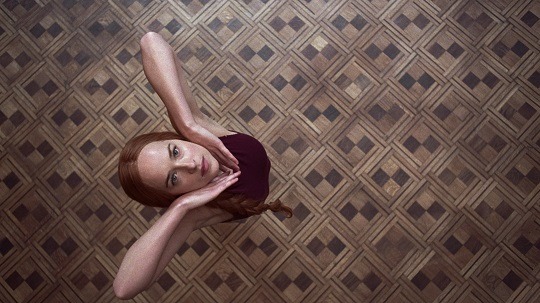
Dune is a reboot. It looks like a revisit to the old David Lynch flick but with Deni’s penchant for the epic. This movie feels like what Jurassic World and The Force Awakens wanted to do; A respectful acknowledgment of what came before but an original take going forward. Dune is one of the greatest sci-fi novels ever written and Deni is one of the most profound visionaries in the game right now. I have no doubt the new film is going to be fantastic. This combination is a match made in heaven, similar to Alex Garland with Annihilation or, more accurately i think, Luca Guadagnino and Suspiria. Those two films are f*cking incredible and they adapt the source material in a very, specific, manner. Annihilation is a reimagining of the book and carries its own themes and tones while the new Suspiria is a complete reinterpretation of what came before, that i believe eclipses the original. Dune looks excellent but i don’t know that it will be well received. Deni has his work cut out for him because the world of revisits is riddle with the corpses of films that couldn’t care the weight of what came before or what could have been. Still, i don’t want Hollywood to stop. As unoriginal as remaking things is, i adore a fresh set of eyes on familiar fare. There are infinite ways to tell the same story and that’s the fun of revisiting an old tale.

2 notes
·
View notes
Text
Disney Live Action Doomsday scenarios
The Lion King is, if there’s any kind of loving god in the universe, going to lose a whole shitload of money. But the thing about movie executives is that they will squeeze an entire quarry’s worth of rocks for even a thimble of blood, so they’re probably going to keep making live-action movies until they generate a loss.
My partner and I have been spitballing, and we’ve come up with the movies they’re most likely to make, existing in a balance between “beloved when the original came out” and “sellable as relevant in the modern day”.
Tarzan is right out, only because there are a million Tarzan movies already, and pretty much the only selling point to the Disney version was that it was done by Disney, and the appeal goes out the window when they make it live action, even if they do cast, I dunno, Ellen as the gorilla.
The Hunchback of Notre Dame was sort of received with an “eh” the first time out, but has been re-evaluated in the years since. There’s stunt-casting potential there, by taking a really pretty actor, say Henry Cavil, and marketing how “brave” he is for spending the whole film under what I would hope is makeup, but would probably be CG, so they could do a dream sequence where he’s as handsome on the outside as his in on the inside, blah blah jerk off motion. Throw that on top of a respected old guy, like Anthony Hopkins of Donald Sutherland as Frolo, and seal the deal with a high-profile WOC, probably Zendaya, as Esmerelda, and you’re fanning the flames of “at least they got a good cast”.
If they wanted to REALLY push it, though, they could try for Pocahontas. The movie was and is considered exceedingly problematic, and Disney know that, and would actually use it to their advantage, in this case. They’d leak that it was in pre-production, and just as everyone was rolling their eyes out of their heads, they’d announce that they were going to cast a SHITLOAD of Native actors, kind of like they did with the Desi actors in Aladdin. That’s an even more underserved population, so they’d actively be daring people to watch it, and be able to dodge and money lost by insinuating that racism hurt the movie’s returns; so sad, not our fault.
Hercules is the same problem as Tarzan, and I personally feel like they really shot themselves in the foot by casting Beyonce in the non-emotive cat movie, because if you can’t cast her as one of the muses, what’s the point? On the other hand, it’s really safe, and there’s an x-factor that I hadn’t considered until recently: underwriting from an outside source. In all seriousness, if they approached Vince McMahon and asked to borrow literally any of the talent from WWE-John Cena, maybe Roman Reigns-he’d fund a big chunk of the budget just to have the brand out there; the man signed off on Flintstones, Scooby Doo, and fucking Jetsons movies because the thought that’s what kids like, he’d hand over a couple million EASY if he thought he could swipe some eyes to his shows, especially seeing how badly they’re hemorrhaging viewers.
But my partner REALLY hit the nail on the head, so accurately it made my butthole retract: The Fox and The Hound. In the current political climate, OF COURSE they’d try to market a movie about how we should all get along. And they wouldn’t even be subtly about it. Todd’s keeper lady would be Whoopi Goldberg, whereas Copper’s owner would be Sam Elliot playing his soutnern-ness to the absolute HILT. They would animate the titular critters, because they probably aren’t going to completely learn their lesson from the current shitfest, and get them played by other young hip properties I don’t care to look up in order to name. They’d send early previews to BuzzFeed and Vox and HuffPo, who would try to make it into some kind of Trump-thing (bonus points is Elliot’s wearing an off-brand MAGA hat or something), and just pump as much fucking money as they could into the performative-ass wokeness of the entire endeavor.
And the real tragedy of all this is that they’ll do all this without ever embracing the Rich Evans approach to remaking, namely to try and remake something that you can make better than you did the first time: Namely, make Treasure Planet again. Don’t even acknowledge that it’s a remake in the first place, just market a zippy, good-looking sci-fi movie with hot people of every taste imaginable (twink, dadbod, cat lady) doing cool space things.
#disney live action#tarzan#hunchback of notre dame#pocahontas#hercules#the fox and the hound#treasure planet#Rich Evans
10 notes
·
View notes
Text
The Little Black Mermaid
There’s a lot to unpack here.
First off, let me start by saying I think it’s very progressive to see a black girl casted for Disney’s live action version of The Little Mermaid. It seems that after 70 some-odd-years, Disney is finally taking steps to represent diversity for this next generation of kids.
Now, I also have to come in and say that I don’t understand why Disney is doing all these live action remakes. I saw Aladdin recently and I could see the love that the creative team put into the costume designs and backgrounds- it was so BEAUTIFUL.
But I also saw something I fundamentally disliked about this new generation of live-action remakes.
See, when Disney does any storytelling, whatever the source, it is scrubbed of much of its authenticity and then sugar-coated for mass consumption for all ages.
Of course, it wasn’t always this way. If you go back a few decades, you’ll see some downright offensive things produced by Disney too; but Disney 2019, is the owner of Lucas Arts and Marvel now. They’re such a massive conglomerate corporation, their image has to be flawless so they can set the pace for each new wave of consumerism.
You’re thinking “Yeah, so?”
So, I’m just going to say, after watching Aladdin, I felt hollow. To get a Disney-filtered animated version of the story, there are a lot of things to weigh and consider. Animation, by and large is a treatment most production companies market toward children. You also have to understand that you can get away with a LOT in animation, because impossible things are possible in 2D animation and everything is intentional.
To take that story that had already been through such an intense filter to make into an animation, and apply that same exact treatment to live-action is moving backwards. Not only that, but Disney took it a step further and made a point to omit any semblance of ANYTHING that could be considered risque in the slightest. Jasmine’s short scene of seducing Jafar was swapped out for a new princess power ballad and left the entire story feeling FLATTER than the 2D Animation. It’s true.
The reason why, is, because all the richness of a story adapted for animation has been applied to live-action. Three dimensional people don’t squash, bend, stretch or emote like cartoons, so the songs, the action, the intensity of it, unless treated like a LIVE-ACTION movie would never add up. And it’s incredibly flat.
The movie has no surprises, no intensity, no complexity and no personality. She looks very pretty though.
Now with that in mind, I’m going to approach the topic of The Little Mermaid. Keeping in mind that Disney is catering their brand toward a new generation of gender-neutral pussies in the making, their message has changed. It used to be “Your prince will come.” but now it’s “You’re a princess, you don’t need a prince.” Taking the “Happily ever after” off of the ending in favor of some “...to be continued” because, it sells. The first go round was so successful, there was all kinds of collectible junk that came out with each classic movie and even new rides for the theme park. People ate that shit up, and Disney is like, “well it if ain’t broke...”, and is now redoing the same projects because, everybody else has done it.
In recent years how many versions of Disney princesses trended? Modern takes with them illustrated wearing casual clothes, On the cover of magazines, Photoshopped to look photo-real, Covered in tattoos, doing drugs etc...
In the past 2-3 years there has been an upward trend, after we came out of our sexy vampire phase (True Blood, Twilight, Vampire Diaries) and went in the direction of modernized fairytales (Once Upon a Time, Grimm, The Hunstman, Descendants). Disney rode that wave until it started to decline and THAT’S when the live-action remakes started.
The Little Mermaid casting choice, plain and simple is a grab at black dollars. I’m not mad at it. But I think it’s very flippant how Disney made such an unexpected move, knowing exactly how Black people would react.
It has mostly been positive. Disney is certainly trending in the black community, and new art of the new black Disney princess is popping up everywhere.
But not all Black people agree. Some don’t even understand why they don’t like the concept, because it does seem like they should be happy, that, for once, color seems not to matter. Which is exactly the problem.
The issue at hand is when white actors are placed in roles that ARE WRITTEN or CALL FOR ethnicities that are NOT White:

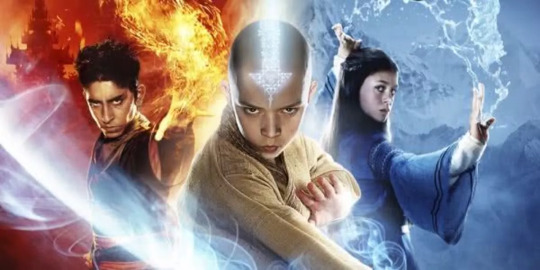

Disney is making an effort.-But not really. I understand why black people are happy, but I also understand why they are upset, and for ONCE white people do have some reason to feel slighted in this situation. The Little Mermaid has been black-washed.
The Little Mermaid is a story written by Hans Christian Andersen in 1837 - who was Danish man from Denmark. SO if you’re under the impression that The Little Mermaid was originally about this “Yemoja” Orisha I’m seeing popping up all over the place from these hoteps that claim they’re woke, that is called “cultural appropriation” plain and simple. We hate that, so let’s not be those people.
The original story is about a mermaid in search of obtaining a soul, and though it is a mythical creature, SUNSHINE is what makes people dark-skinned. If you live underwater, in DENMARK of all places, fuck white, this fish would be damn near transparent.
This was one of the times where Disney didn’t have to worry about appeasing black people. If Ariel was casted White, Black people wouldn’t have cried about it being unfair because that would be accurate. NOBODY petitioned, going around asking for signatures, demanding that Ariel be black, and now, White Disney supporters are feeling slighted, and rightly so, because Disney isn’t trying to balance the scales, so much as perpetuate the message that they “don’t see color” and “race doesn’t matter”; and Black people hate that narrative!
It’s like when you get into a fight with your little sister or brother growing up and your mom makes you apologize, even though they started it. To your mom, it doesn’t matter who started it, and even though it’s unfair, she forces you to humble yourself even if you were the victim. That’s not balance, it’s a forced compromise.
We need to stop being so eager to jump on the bandwagon of any pitiful handouts they give us, especially if it’s not coming from a pure place of good intent. White people will buy new merch to burn and Black people will buy anything that has their face on it, so both ways, Disney wins.
I love Disney, but this was a blunder on their end. Halle Bailey’s singing chops in a Disney movie is not going to even get close to showing off her skills or range as a vocalist since Disney songs are all written in keys and chords that the general public can sing along with.
Personally, I think Disney could have been better about choosing a character that more matched the Ariel we already know and love. It’s not like we are starting from scratch. We already have a red-haired, fair-skinned mermaid girl, who we know and love from the 2D animation. If you’re RE-MAKING the movie, why not make it in the image of the first success?
Don’t change the main character’s color on a whim. If Disney was RE-IMAGINING The story, then it’s okay. Tweak the story. If it takes place in the Carribbean, maybe with some influential cultural tweaks like the prince being from Barbados (Sebastian can obviously stay the same), and maybe some pirates thrown in, it could be good, and Halle Bailey would be a wonderful casting choice, just like Brandy was in Rodger and Hammerstein’s version of Cinderella. But it wouldn’t be a REMAKE.
But if it’s going to be a remake, as I recall, I do believe the Disney’s version took place in The Caspian sea, according to Ursula’s spell.

I never felt like I couldn’t relate to Ariel because she was white, A mermaid isn’t a human in the first place. We’re 2 for 0 in black women getting the “another species/race/creature” treatment with Disney. A princess that was a frog and now a mermaid and we’re playing it up like a victory while Disney is about to make some serious coin off of us.
That’s all folks.
8 notes
·
View notes
Link
A sea change has taken place in American political life. The force driving this change is the digital era style of moral politics known as “wokeness,” a phenomenon that has become pervasive in recent years and yet remains elusive as even experts struggle to give it a clear definition and accurately measure its impact. Where did it come from? What do its adherents believe? Is it just something happening inside the Twitter bubble and on college campuses or is it really spreading across the social and cultural landscape and transforming the country as sometimes appears to be the case? In reality, “wokeness”—a term that originated in black popular culture—is a broad euphemism for a more narrow phenomenon: the rapidly changing political ideology of white liberals that is remaking American politics.
Over the past decade, the baseline attitudes expressed by white liberals on racial and social justice questions have become radically more liberal. In one especially telling example of the broader trend, white liberals recently became the only demographic group in America to display a pro-outgroup bias—meaning that among all the different groups surveyed white liberals were the only one that expressed a preference for other racial and ethnic communities above their own. As woke ideology has accelerated, a growing faction of white liberals have pulled away from the average opinions held by the rest of the coalition of Democratic voters—including minority groups in the party. The revolution in moral sentiment among this one segment of American voters has led to a cascade of consequences ranging from changes in the norms and attitudes expressed in media and popular culture, to the adoption of new political rhetoric and electoral strategies of the Democratic Party. Nor has this occurred in a vacuum on the left as the initiatives set in motion by white liberals have, in turn, provoked responses and countermeasures from conservatives and Republicans.
…
As white liberals have come to place far greater emphasis on racial injustice, they have also endorsed reparative race-related social policies in greater numbers. This is evident across a range of issues: the rapid growth in white liberals who favor affirmative action for blacks in the labor force; in the increase in white liberals who feel that we spend too little on helping blacks, and that the government should afford them special treatment; in the increase in white Democrats who think it’s the government’s job to ensure “equal income across all races”; and in the increase in white liberals and Democrats who think that white people have ‘too much’ political influence.
…
Some of these changes arguably stem from Trump’s rhetoric and policies on immigration. But a glance at the data shows that, as with their attitudes toward blacks, the percentage of white liberals perceiving “a lot” or “a great deal” of discrimination against immigrants more than doubled between 2000 (29%) and 2013 (57%)—i.e., well before Trump arrived on the scene. Additionally, between 2006 and 2014, the percentage of white liberals saying they feel “very sympathetic” toward illegal immigrants and their families grew from 22% to 42%.
For the woke and their allies, these rapid changes are heralded as signs of progress, leading at times to harsh criticism of anyone who would stand in their way. This ideological stridency and triumphalist attitude can be powerful weapons against political opponents but are alienating—perhaps deliberately so—to moderates and conservatives. But, in a sense, no one is put in a more strained and problematic position by the politics of white liberals than the white liberals themselves. The woke elite act like white saviors who must lead the rest of the country, including the racial minorities whose interests they claim to represent, to a vision of justice the less enlightened groups would not choose for themselves.
Consider, for instance, that black and Asian Democrats and liberals are significantly more supportive of restrictive immigration policies and less positive toward racial/ethnic diversity than their white counterparts. Black and Hispanic Democrats and liberals are more sympathetic toward Israel than the Palestinians (likely due in part to the fact that they tend to be more religious). They are also more likely to part ways when it comes to contemporary social and gender-identity issues, including views of the #MeToo movement. In all, though they do converge on some issues, the attitudes and policy preferences of the woke white left are unrepresentative of the “marginalized communities” with whom they are supposed to be allies. And as woke liberals play a leading role in party politics, the Democrats, who are increasingly defined by their embrace of diversity and progressive stances on issues of racial justice, appear to do so, at least partly at the direction of a small white elite.
…
Remarkably, white liberals were the only subgroup exhibiting a pro-outgroup bias—meaning white liberals were more favorable toward nonwhites and are the only group to show this preference for group other than their own. Indeed, on average, white liberals rated ethnic and racial minority groups 13 points (or half a standard deviation) warmer than whites. As is depicted in the graph below, this disparity in feelings of warmth toward ingroup vs. outgroup is even more pronounced among whites who consider themselves “very liberal” where it widens to just under 20 points. Notably, while white liberals have consistently evinced weaker pro-ingroup biases than conservatives across time, the emergence and growth of a pro-outgroup bias is actually a very recent, and unprecedented, phenomenon.
…
For most of human history, the primary trigger for moral emotions like outrage came from local acts of wrongdoing. After all, if you have no idea what events are going on outside your village and hardly any sense of the world at large, it’s hard to be outraged by them. In the modern era, however, this is rapidly becoming less true. Along with drastic improvements in material well-being, which, some argue, has enabled individuals whose immediate needs are met to shift their to concern to the welfare of people they’ve never met—modern technology has widened our exposure to injustices against strangers. The diffusion of the internet, social media in particular, has enabled people from across the globe to document and upload their every moral grievance. In a recent study, respondents reported experiencing significantly greater exposure to immoral acts and expressed greater moral outrage online vs. in person or through traditional media platforms (newspaper, TV, radio, etc.). Meanwhile, other recent research finds that morally “outrageous” content is retweeted, shared, and commented on more frequently than all other material in circulation. And with algorithms tracking what you click on so as to direct you to similar stimuli in the future, political social media consumers are being fed a steady supply of outrage.
…
Thus, by all indications, the first half of this decade appears to have been a watershed for white liberal racial consciousness. The picture that emerges from the various points of data is one in which white liberals and social media created a kind of outrage feedback loop. White liberals started spending ever increasing shares of their time in a medium—social media and internet news sites—at the same moment that, for multiple reasons, that medium produced a higher volume of race-related moral outrage stories relative to other forms of journalism. Exposure to the stories on those sites, in turn, generated moral outrage among white liberal readers who then fed that emotional response back into the sites, which catered to their appetites as consumers, thus powering the feedback loop. Liberals tend to have an “unjust world bias” as it is; but digital media ensures that this disposition is frequently reinforced.
…
Along with the sweeping changes on race and immigration issues is the reversal of white liberal attitudes toward Israel. Between 1978 and 2014, white liberals consistently reported sympathizing more with Israel than the Palestinians. Since March of 2016, this trend has turned on its face. Currently, significantly more white liberals report greater sympathy for the Palestinians than for Israel.
…
The surveys show that among white liberals, Jews are perceived to be privileged—at least in comparison to other historically victimized groups. Having made a full recovery from the Holocaust, Jews are no longer the downtrodden collective that white liberals can readily sympathize with. Other groups lower on the privilege hierarchy and less tainted by association with whiteness now have priority. So long as anti-Semitism has a white face to it, there is no problem here. But if the face is actually that of a member from an “oppressed” or “vulnerable” group, there may be a cognitive dissonance.
…
A wealth of research shows that elected officials are most responsive to the voices (and campaign contributors) they hear from the most; and, by many measures, white liberals and Democrats are the most politically active group on their side of the partisan aisle. White liberals make up 20-24% of the general population but, for a multitude of reasons, exert an outsize political and cultural influence. They are more likely to consider themselves activists, are more active on social media, and, significantly, they are one of the most affluent groups in the country. Of course, small groups of vocal and determined minorities can drive positive changes and spur social progress. The danger is that “woke” white activists acting on behalf of voiceless minorities have had their perceptions distorted by social media-tinted caricatures that obscure more objective measures of reality and end up silencing or ignoring what the voiceless groups, themselves, have to say about what policies are in their best interest.
…
Due at least in part to digital media, white liberal attitudes that more or less endured for decades have been drastically overturned in the space of months or single years. In contrast, the attitudes of white conservatives—and conservatives in general—have moved at a more glacial pace, if at all. For liberals, the lack of awareness of how fast and far their attitudes have shifted fosters an illusion of conservative extremism. In reality, the conservatives of today are not all that different from the conservatives of years past. And it’s the frustration with white conservatives’ inability or reluctance to keep pace with liberals on the path to enlightenment that is intensifying our political divide. But conservatives tend toward normative and structural stability. They don’t take well to rapid social change. The perceived imposition and spread of progressive norms naturally elicits psychological reactance—a visceral desire to resist and affirm one’s agency in the face of perceived social pressure. This is the very process that is at least partly responsible for the election of Trump.
Resentment of those seen as standing in the way of necessary social and cultural change may inspire a commitment to what political scientist Eric Kaufman calls “multicultural millenarianism”: the belief that the demise of a white majority will pave the way for a more racially progressive and just society. Perhaps this is why white support for increasing immigration coincides with more negative feelings toward whites. Whatever the case, such sentiment would have been hard to fathom 10-20 years ago. The digitalization of moral outrage that makes it possible today could, with the pace of innovation, make it even more potent in the years to come.
2 notes
·
View notes
Text
What should a “Yugioh Remake” do, if it hypothetically existed?
On the one hand, I get where people wanting a full, filler-free, “accurate” anime adaption of the Yugioh manga, are coming from. The Toei series has a lot of divergences from the manga, and ends before it even really gets a chance to begin, while Duel Monsters combines a suborn refusal to properly adapt the early manga (resulting in the first season being confusing nonsense) and entire seasons’ worth of filler. In light of those options, “accurate” sounds pretty good.
But I think an ideal adaption of Yugioh, made long after the manga ended, with all the hindsight that provides... actually would make significant changes.
I have two good reasons I can think of, off the top of my head.
First, the storytelling argument. One advantage an adaption made after the fact has? It has a full blueprint for where the fuck its story is going. That’s especially important to take advantage of if the original material was clearly written by the seat of the author’s pants.
Second, the moral argument. Sometimes, we look back at older material, and we see that while it has some good and interesting ideas, it’s also got things that are...incredibly offensive. I’d argue that, in those situations, it is the moral duty of an adaptation to make the material less shitty.
The Storytelling Argument
Look at the 2016 adaptation of Jojo’s Bizarre Adventure, Part 4: Diamond is Unbreakable. Araki is infamous for writing things by the seat of his pants, and as such he had no clue who the main villian of Part 4 was until he introduced Yoshikage Kira, sixty-nine chapters into the story. When production for the anime adaptation began, though, he specifically requested that new scenes foreshadowing the character be added in. These additions, as well as other added scenes that tie the plot together, have for the most part been praised. I’ve even seen people say the anime version of “Diamond is Unbreakable“ is superior to the original manga, namely because of its changes and additions!
Anime-only content doesn’t have to be used or seen as useless “filler.“ If a story has serious problems with pacing and cohesion in its original form, anime-only content can be used to improve the story structure... perhaps even to the point where the adaptation can be considered superior to the original.
And BOY does Yugioh have narrative problems, that its main anime adaptation was in absolutely no position to be able to fix.
The genre shift from schoolyard supernatural gambling horror to TCG tournament battle shounen is extremely sudden and abrupt. And, like, it’s understandable why this happened, looking at what we can glean about the behind-the-scenes happenings between Takahashi and Shounen Jump. But it doesn’t make it any less horribly jarring while reading. Surely, some more school-arc content to bridge the six-month gap between Death-T and Duelist Kingdom, and let Yami Yugi’s development into a more protagonist-like character be better shown to the audience...couldn’t hurt, you know?
Because the Toei adaptation was canceled before it could reach Duelist Kingdom, and the NAS adaptation skipped basically everything that the Toei series adapted, neither adaptation was in a position to “bridge the gap“ -- conceptually, chronologically, or tonally -- between the early manga and Duelist Kingdom. Also Battle City is an oversized slog of an arc and needs to be shortened and spiced up, not padded out with filler intermissions.I know why those filler arcs exist, it’s for the reasons filler arcs ALWAYS exist, but still.
And of course we all know Millennium World is a MASSIVE shitshow, not least of all because it was rushed out as fast as humanly possible by a guy who was high on pain meds and missing a huge chunk of his blood, and while the anime kind of tries to improve it it doesn’t do a great job and even adds some things that are actively worse (like More Bobasa Scenes) and just. There is a lot of room for improvement here. We could even make it more historically accurate! And I hear you saying why does that matter this is Card Game Egypt but shhhh.
Also in general, more foreshadowing, more consistency across arcs for various characters, explain a bit more about what the fuck is going on with Shadi and Yami Bakura so that they Make Fucking Sense As Characters, etc.
The Moral Argument
A good example is outlined in this blog post about Cyborg 009. In the original 1964-1981 manga run, one of the 9 international cyborg heroes, Pyunma, is African... aaaaand he’s drawn as a horrible golliwog caricature. But from 1980 onwards, the character’s design in animated adaptations has been massively overhauled. He’s in a cartoony, 60′s anime-esque style... but he’s now recognizably a human being, an anime character who just happens to be black.
I know there’s already a post about this going around, but... Yugioh definitely has issues in how it depicts egyptians. The major characters like Shadi, the Ishtars, and all the major players in Ancient Egypt? Drawn like normal fucking people, and written similarly to the Japanese and white American characters.
Nameless bit-part egyptians, though? (Let’s...not get into Bobasa for now.)

ZOINKS. This is especially bad in flashbacks depicting modern Egypt, where the only non-millenium-item-related Egyptian citizens Takahashi ever deans to show us are grave robbers. But it shows up in Millennium World, too.
Some of the Ancient Egyptian commoner crowds, while not Peak Anime, are pretty normal-looking people, with relatively realistic, average-looking faces:
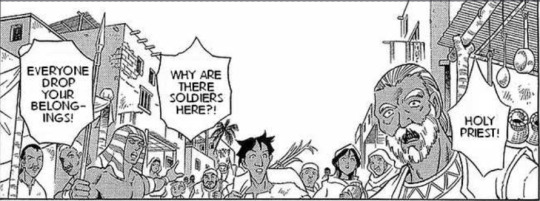
But then we go into some bars, and both times:

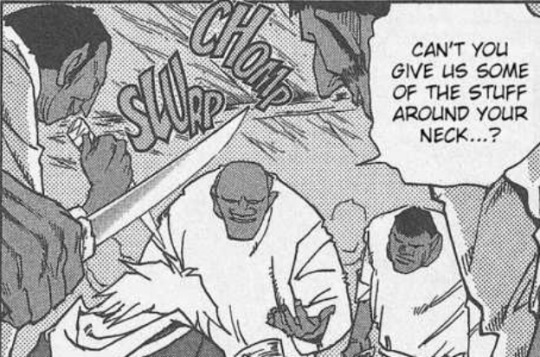
Ah. There’s the huge-nosed racist caricature cannon fodder thugs who exist solely to be selfish and die horribly.
Needless to say, this uh. This really shouldn’t be a thing, much less a recurring thing, in a responsible remake of Yugioh. The manga also has issues with sexism, abelism, etc. I’m not sure if it’s reasonable to expect 100% of these problems to be fixed by a rewrite, but. Considering Toei, in 1998, removed the early manga’s Unbelievable Horniness and added more girls, I think it’s only fair that a 2020′s or later reboot could do all that and cut down on the racism.
You know, at the very least.
8 notes
·
View notes
Text
Welcome Back
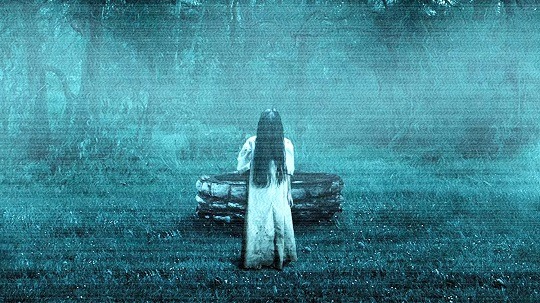
I am a card carrying geek. I was that nerd in grade school, reading comics, watching anime, and larping with his friends during recess. I’ve always loved things like books and film, mostly because my ma had a penchant for the sci-fi and we would share in her hobbies. I’ve been a fan of Doctor Who since i was a wee lil’ Smokey and had a particular fondness for Max Headroom’s shenanigans. My chosen proclivities lend themselves to alternate universes, divergent timeless, and the interdenominational doppelganger or two. What i am trying to convey, here, is that i am not stranger to the revisit of a franchise. For me, rebooting an established work or expanding a loved lore is not a transgression. I am a fan of narrative. If you can tell a unique story, it really doesn’t even have to be that good, but something creativity and compelling, i am totally on board. This isn't as difficult a feat as you'd think considering how well Hollywood can adapt international films. The Ring and The Departed are effectively remakes of their original Asian fare and those films are spectacular. Nolan’s Dark Knight trilogy is the best example of this i can give. His deconstruction of the Batman mythos was one of the best cinematic and storytelling experiences I ever had. If you can take an established narrative, an established universe, and inject your own flavor into it, i am down for that, too. The Kelvin Star Trek timeline immediately comes to mind. Again, comic book guy, specifically a Spider-Man shill.

While i have years worth of alternate Spider-Men in the books to pull from, i think the most concise example i can give for a layman is to think Into the Spider-Verse, only with thousands more Spider-Men and Spider-Women. That’s the world I'm broaching this subject from, where there are decades worth of stories and reboots and remakes and reimagings, basically revisits, of a character that i absolutely love. Some are great like the Ultimate Spider-Man or the world of Renew Your Vows, and some are not so great, like that version Abrams’ kid came up with. That whole story was the worst. We have actually seen a little bit of this narrative reincarnation in the Spider-Man film franchise, itself, both good and bad. If we take the very first Spider-Man films, those campy, Raimi classics, as a starting point, then we had a terrible reboot in the Amazing franchise and a rather brilliant reimagining in the MCU outings. I really like the MCU retool. Tom Holland is THE onscreen Peter Parker and you can fight me about it all day.
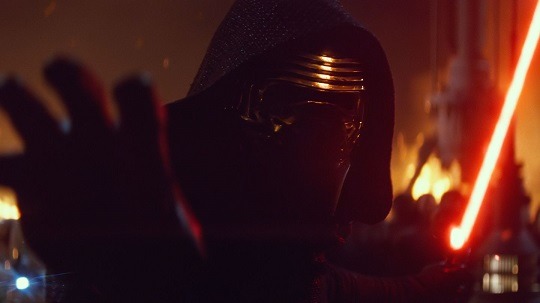
Jurassic World and The Force Awakens are an interesting situation in the whole Revisit discourse. Both of these films are effectively reboots of the entire franchise and a whole ass remake of their initial entries. Beat for beat, theme for theme, these two films are basically the same as Jurassic Park and Episode IV, just less than they are in every conceivable fashion. Now, on paper, i should hate this but i don’t. There is a reason both of the imitations made billions for their respective franchise and that is simply nostalgia. We. as a culture, were starved for a Jurassic sequel and new Star War. When we got these movies in earnest, no one cared they were rehashes of the films that made them so important to the cultural zeitgeist. It was like seeing A New Hope and that initial outing to Isla Nublar for the first time, for a second time, but with much better effects. It had been decades since either of these movies had a proper release so we all just accepted that these were refresher courses in the lore. It was with the sequels that these things sh*t the bed so hard.

Fallen Kingdom and The Last Jedi skewed so far from what these franchises were, from the rules that had been established in the preceding films, including the first in their new trilogies, that they were offensive. Legitimately offensive. Jurassic World and The Force Awakens, as flawed as they were, left their worlds in respectable places. The narratives that could be built from those starting point were incredible. That potential was palpable. Lucas, himself, said that the stories should rhyme and you see that in his six films. Familiar yet different. Nostalgic yet original. Respectful yet original. None of that was recognized in the follow-ups and that is why these two franchises are on life support. It’s sad because there was potential there. Characters introduced were compelling and narrative threads left unties, could have become something great. Instead, expectations were subverted and the world completely sh*t on in an effort to be edgy, to distance itself from the established lore. That sh*t is whack. It’s not about being a fan of the franchise or a zealous istaphobe or whatever else the Twatter mob wants to accuse people of being. It’s about bad story telling. it’s abut a complete betrayal of a decades old franchise. It’s a bout being disingenuous with the property for personal gain.

I said at the beginning of this essay that i love a revisit. That’s why i went to see these sh*tty films. I also made very clear that i love storytelling. Fallen Kingdom and The Last Jedi lack in that fundamental aspect, that’s why they suck. They’ve done irreparable damage to the entire franchise and canon of these worlds that were so meticulously crafted by proper visionaries. Michael Crichton is rolling in his grave at what became of his Dinosaur Westworld and Lucas effectively bogarded his way into running Lucasfilm again after they sh*t on his legacy and that’s the thing; Legacy. These two franchises are part of American culture. They’re as revered as Apple Pie and Institutional Racism here. They’re not cash grabs or vehicles to push your politics. They’re modern fairy tales, myths, and should be respected as such. The thing is, though, i don’t believe there are actual creatives out there that have the vision to create like Crichton or Lucas anymore. Or, at least, Creatives that are willing to work within the constraints of this ridiculous studio system.
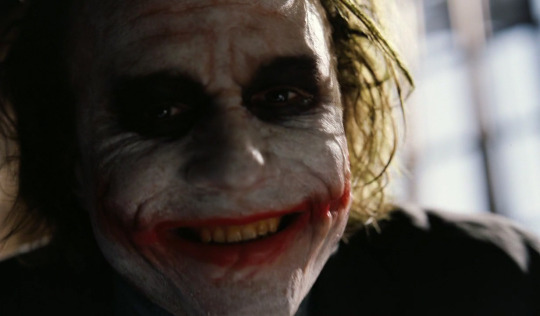
Modern film studios are disgustingly risk averse. That is a problem with anything making entertainment media nowadays but it’s most egregious in Hollywood. Films like Star Wars and Alien were made in a time when budgets didn’t swell to hundreds of millions of dollars so directors had to do what he could, with what they had, and that level of imagination birthed classics. It’s rare that creators get a blank check to deliver their vision nowadays, and even rarer that what they get to make if they receive that loot, is actually good. Zack Snyder and the train wreck that is Sucker Punch demonstrates my point perfectly. the new Lucases and Camerons are rare but there are a handful of directors who carry that torch. Denis Villeneuve is an incredible visual storyteller. He has a distinct vision for the grand and manages to craft proper worlds. Blade Runner 2049 is one of the best films i have ever seen in my life but it didn’t make money because people have been conditioned to ignore great storytelling for great effects. That sh*t is why people can say to me, with a straight face, that they think Batman v. Superman is better than The Dark Knight rises. That sh*t is stupid, shut the f*ck up. Deni was given the reigns to the Dune reboot and i think this might be the film that breaks him through to the mainstream.

Dune is a reboot. It looks like a revisit to the old David Lynch flick but with Deni’s penchant for the epic. This movie feels like what Jurassic World and The Force Awakens wanted to do; A respectful acknowledgment of what came before but an original take going forward. Dune is one of the greatest sci-fi novels ever written and Deni is one of the most profound visionaries in the game right now. I have no doubt the new film is going to be fantastic. This combination is a match made in heaven, similar to Alex Garland with Annihilation or, more accurately i think, Luca Guadagnino and Suspiria. Those two films are f*cking incredible and they adapt the source material in a very, specific, manner. Annihilation is a reimagining of the book and carries its own themes and tones while the new Suspiria is a complete reinterpretation of what came before, that i believe eclipses the original. Dune looks excellent but i don’t know that it will be well received. Deni has his work cut out for him because the world of revisits is riddle with the corpses of films that couldn’t care the weight of what came before or what could have been. Still, i don’t want Hollywood to stop. As unoriginal as remaking things is, i adore a fresh set of eyes on familiar fare. There are infinite ways to tell the same story and that’s the fun of revisiting an old tale.

0 notes
Text
Soulcember Day 3:
Count Down; AU in which there is a timer on their body that counts down until they meet.
Fandom: Septimus Heap
Pairing: Marcellus Pye and Marcia Overstrand
Modern AU
A/N: (feat. Septimus)
Timeless
Marcellus Pye, a noted and well-respected Alchemist, hardly ever gave much thought to soulmate. Sure, he had a timer on his arm that showed how long it would be until he met his soulmate, but he rarely even looked at it. However, he knew that the numbers were abnormal. They were significantly higher than anyone he had ever seen. Centuries higher. It wasn’t until he made a breakthrough in sustaining youthfulness and longevity of life that his timer began to make since. It meant he would succeed! He would discover a way to live for at least another five centuries! Knowing that brought him to throwing everything into his work. Once he could live forever, he could unlock every other secret in the world!
Sooner than he expected, Marcellus found himself five hundreds older with endless awards for his breakthroughs in science, yet he always kept the eternal youth to himself, often changing his name and remaking identities in order to avoid suspicion. He was now working for an extremely prestigious school in a wealthy city as one of the most respected professors.
Marcellus, referred to as Dr. Pye by his students and professional peers, enjoyed teaching group after group of students, though very few showed much interest or promise in the field. But one student caught Marcellus’ attention: Septimus Heap, an exceptional boy that had gotten into the school several years early for his incredible talent in Magykal studies.
Septimus had an obvious gift for Alchemy as well, and Marcellus thought it a shame that Septimus was so focused on Magyk that it took all his free time. It was then that Marcellus had a brilliant plan. He discussed it with Septimus himself, and Septimus seemed excited by the proposed idea: he could come and work in the lab in the two hours before his private Magyk lessons.
Marcia Overstrand paced in her tidy office while glancing at the clock repeatedly. The student that had scheduled himself for advanced private lessons was, again, late. He had promised last time that there wouldn’t be another incident, but here he was, late for the eighth time in the past two weeks. Suddenly, Septimus burst into the room, clearly distressed.
“I’m so sorry, Marcia. I lost track of the time and the moment I noticed I came running,” he said, breathing heavily between words.
“Clearly the next thing I should teach you is how to Conjure an accurate timepiece. Maybe after that you’ll stop rushing in here twenty minutes late,” Marcia scolded while crossing her arms.
“I know, I’m sorry Marica. I have been practicing though, if that helps,” the blonde boy said while putting the various books in his arms down on a table.
Septimus quickly sat down and began to prepare for the class. Marcia walked around the office, organizing things as she went. Once she walked past Septimus, a power scent infiltrated her nose. It smelled strongly of garlic. In fact, the smell was so prominent that Marcia was surprised she didn’t smell it when Septimus entered.
“Septimus...What’s that smell?” Marcia asked. Septimus usually kept himself quite clean and fresh. The moment she finished her question, Septimus stiffened.
“Did some get on me?” Septimus muttered with a worried look.
“Did what get on you? You know, Septimus, I’d be very interested to know exactly what you’re doing that makes you be consistently late.” Marcia said, crossing her arms and staring down her student.
“Uh, my sister….” Septimus began but trailed when he saw Marcia’s unconvinced face.
“You have a two hour break between your last class and these lessons. That gives more than enough time to enjoy some free time then arrive here punctually. If you were late only once or twice, I wouldn’t say anything, but you’re starting to be consistently late suddenly. You were never late before. So, what changed? What keeps making you so terribly late?” Marcia demanded, growing irritable.
“I-I’ve been spending my free time in the Alchemy Lab!” Septimus admitted quickly.
“The Alchemy Lab? You’re not to be in there without supervision of a teacher! Some of the things in there are extremely dangerous,” she said, her anger mixing with concern.
“There is a professor…” Septimus muttered.
“And who would that be? Surely not a very good keeper of time,” Marcia commented.
“Dr. Pye…” he said.
“Dr. Pye? As in Dr. Marcellus Pye? Why are you messing around with Alchemy when you should be enjoying free time before my lessons?” Marcia snapped. She didn’t trust Alchemy, nor Alchemists. Who needed it anyway when there was Magyk?
It was then that a small knock on the door which prevented Septimus to reply that it was his free time and he could do as he pleases. Marcia marched to the door, still very much angry that her special student was messing about with Alchemy of all things. She opened the door harshly to see who wanted to bother her at this moment.
Marcellus had been walking briskly to Marcia Overstrand’s office. Septimus had left his Private Studies Journal in the lab, which he would certainly need. Marcellus was acutely aware that his timer was almost to zero, and he’d hate to miss the meeting he’d waited for five hundred years for. But Septimus needed this book. So, Marcellus was rushing to the office of Marcia Overstrand, head of the Magykal Department of the school and ExtraOrdinary Wizard.
He knocked timidly on the wooden door. Marcellus had heard several stories about Marcia Overstrand and how intimidating she could be and how she absolutely hating others, even administration, interrupting her work. The door was quickly opened by an irritated Marcia, and Marcellus knew he had spelled doom for himself. This was it 537 years lead to dying by the hands of an angry woman.
“What?” she snapped. Despite being quite intimidated, Marcellus couldn’t help but notice how well put together Marcia Overstrand was. She was a tall, sturdily built woman with amber skin and long dark curls. Her black suit with purple top seemed to compliment her in every way. Marcellus quickly forced his thoughts to the purpose of coming there.
“My student left his book in the lab,” Marcellus said, attempting to sound bolder than he felt. One of Marcia’s green eyes twitched. With a single quick motion, Marcia took the journal from his hands.
“Thank you. Now if you don’t mind, Dr. Pye, I must get back to teaching my student that was twenty minutes late.” Marcia jeered already beginning to close the door.
Marcellus wasn’t sure why, but he wanted to stay. Quickly glancing at his arm, he realized the numbers now all stated zero. Marcia Overstrand, the woman with bold green eyes and a strong personality, was meant to complete him. His soulmate. Marcellus wouldn’t believe it unless the evidence was apparent on his arm, not to mention centuries of evidence proving the reliability of the timers.
“I know this is a bit forward of a question, but what number is displayed on your timer?” Marcellus blurted before Marcia could completely close the door.
“What?” Marcia asked dubiously, keeping the door partially opened. She made no motion to show her timer, located on her forearm.
“Please, Madam Overstrand, I’ll leave directly after,” Marcellus pleaded. He had to know. This would be the only way to know for certain.
“Fine, but only to get you to leave,” Marcia said. She began to carefully roll up the sleeve of her suit jacket and shirt to reveal the timer.
Marcellus’ breath caught in his throat. The numbers read zero like his, but it was possible that Marcia had met her soulmate some time ago. When there was silence in response to the showing of her timer, Marcia glanced at it herself. Her eyes instantly widened. Zero?! But this morning it had several hours! Did time truly move that quickly without her realizing? How long had it been zero? She hadn’t met with anyone she hadn’t already met before. Did she meet her Destined partner without even realizing it?
“My teachers are soulmates?!” Septimus exclaimed from his seat, having been able to see the whole ordeal. Both Marcellus and Marcia looked at Septimus in shock, neither expecting his outburst.
“Well...A promise is a promise, Madam Marcia. I’ll leave you to your lesson,” Marcellus said softly, turning to leave.
“Wait,” Marcia said. She didn’t want to admit it, but Marcellus seemed likely to be who she was Destined to be with. She also couldn’t help but be charmed by his style and composure, even if it seemed outdated by a large margin. “I’ll be done here in about two hours. Would you be willing to come back here then? I feel like we have a good bit to talk about,” Marcia said.
“I have all the time in the world, Madam Marcia. Until then,” Marcellus said with a slight bow. With that, he left, and Marcia turned her attention to Septimus.
“Don’t think this means you get off for being late again, young man. Now show me just how much you’ve ‘practiced’, as you claim,” Marcia said to her student. Said student instantly stopped smiling and almost complained, but he knew better than to try. Marcia smiled a bit to herself as Septimus prepared his Magyk. Perhaps, Septimus being late hadn’t been such a bad thing.
5 notes
·
View notes
Text
What the hey, AJ? | First Assault [Volume: January 2019]
YES, THE TITLE IS COMPLICATED.
Hi - if you’re reading this, you know the drill. My name’s MetaVanAJ, insert quirky catchphrase and/or ‘your mum’ joke here. Welcome to the first volume of ‘What the hey is AJ play...ing?’ Yeah, the title isn't the greatest but hey it rhymes...mostly. I just thought I’d use this as quick way of communicating what I’m playing (or going to play) at the moment, & hopefully give some quick recommendations, to pique your interests in some really good stuff. As much as I would love to do a video version of this, I feel I would lose the spontaneity behind the idea; once I get my shit together I’ll do one of these in video form, someday. The only reason I’m writing this now is because January 2019 is so jammed packed with excellent NEW titles (despite most of this article being about ports & remakes), that I literally won’t be able to keep up. And I can’t even keep up in an off-season so this is just exponentially worse. So, ‘what the hey is AJ playing’ in January 2019?
Travis Strikes Again: No More Heroes

(Platform(s): Switch | Release Date: Jan 18th)
Travis Strikes Again: No More Heroes is taking another core title hostage so please buy this game. Joke aside, I am still looking forward to this title. Like everyone else, I’m a bit iffy and uncertain about how the gameplay is shaping up but I’ll be picking this up day one. Why? For one reason only, of course: Suda51. You see Goicha Suda is a brand - he is a different, ‘special snowflake’ and he makes different ‘special snowflake’ games. His name has been slapped on various works the past decade, and then some, but he actually hasn’t directed a game since 2007’s No More Heroes, on the Nintendo Wii. Travis Strikes Again marks his return to the directorial seat, albeit an odd-way to do so. But hey, this means pure unadulterated Suda-vision, the same vision that gave us Killer7 and No More Heroes; meaning narrative-wise we’re up for, what the kids call, some wacky shit. That and being able to blast through this with a bud, in co-op, will ease any of the pain, if the gameplay isn’t to mechanically engaging. Pain divided...is worse - why would you subject your friend to that?
Tales of Vesperia: Definitive Edition

(Platform(s): PS4, Xbox One, Switch, PC | Release Date: Jan 11th)
I saw someone call the ‘Tale of’ series the McDonalds of JRPGS - I don’t think that’s an accurate metaphor but hey it’s an interesting way to open up a paragraph, no? Tales games tend to be a bit ‘same-y’ but it’s a bloody excellent formula and the fact they’ve released so many of these over the years just goes to show the formula works. Don’t like the characters, story & setting of one Tales game? Play the next one - gameplay remains the same, fundamentally. I won’t dive into the gameplay deep here but let's just say the ‘action’ is pretty decent in this ‘action-RPG’. Personally, you can’t go wrong with any Tales after Tales of the Abyss (Symphonia didn’t click with me, my bad). Apparently, Vesperia is one of the best in the series, so if it’s half as good as Abyss, and what I’ve seen of Xillia, then this is definitely worth a buy - especially on Switch, so you can take this bad boy on the go. Don’t worry, high-frame lovers: it was 60fps on the 360 in 2008, it’ll a good time, trust me. And this is one also has a dog with an eye patch in it...and a pirate midget. The definitive edition also adds all the extra goodies from the japan exclusive PS3 port, which is all the more reason to pick up a copy now. LIKE RIGHT NOW.
New Super Mario Brothers U Deluxe

(Platform: Switch | Out now!)
Eh, I’m not super excited about this game in particular but moreso the idea of the game itself. Shocking fact: New Super Mario Bros. games have been decent this entire time. The games have no spunk, in terms of story and presentation, but boy is the level design tight & fun. If you’re looking for a good 2D platformer on Switch, get Donkey Kong Country: Tropical Freeze, or hey even Shantae ½ Genie Hero. The other big 4-player party-style offerings however, have been kinda meagre offerings. Super Mario Party looks boring and soulless, Kirby: Star Allies is patronisingly easy to a point of being ‘unfun’ (and that’s for a Kirby game), and I forgot how to casually play Smash without crushing people’s dreams. Super Mario Bros. U is a great platformer and even greater with a few buddies but I’m not clamouring to get it at full price. I still strongly recommend it though if you’re just looking for some 4-player platform ‘em up fun. Comes with Luigi U too, that’s nice - surprised they didn’t charge us for it, all over again. That’d be almost as bad as charging a full 80 Australian dollars for it...oh wait.
Resident Evil 2 [2019 remake]

(Platform(s): PS4, Xbox One, PC | Release Date: 25th Jan)
Legitimately thought, I don’t need to sell you this one. You saw the trailer, you’re probably already hyped that Resi is ‘returning to its roots’; whatever that means. Personally, I haven’t touched Resident Evil up until recently, as I am a big baby when it comes to jump-scares. I know their coming but I still go through the physical shock of getting scared by set jumps. The titles I have been delving into (and loving) of late, have been Resi 4, 5 & 6...all at once - and I wonder why I can’t tame the backlog? Anywho, that’s why I am excited for the Resi 2 remake. Why should YOU be excited? The Resi 2 remake takes from all the best components of the series, and smooshs them together to create something extraordinarily beautiful - the actual horror elements and sense of claustrophobia through environmental design from the first three classic games, the tight gameplay formula from the modern Resi formula (4, 5, 6) and the beautiful new engine from Resi 7. Resident Evil 2 (2019_ is like a best hits album of everything the series has achieved so far. Play it, yeah - you owe it to yourself.
Kingdom Hearts freaking III
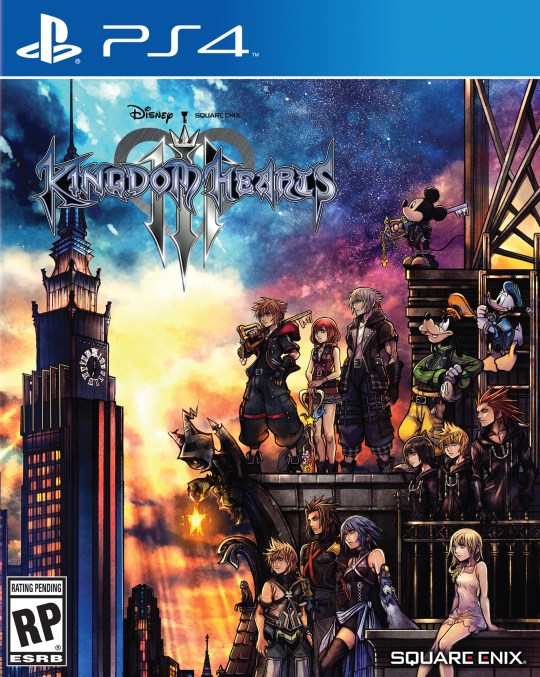
(Platform(s): PS4, Xbox One | Release Date: 29th Jan)
At this point, you are either on the Kingdom Hearts hype train, or you live in beautiful bliss of the Kingdom Hearts hype train. I got in an abusive relationship where whenever I thought about Kingdom Hearts 3, I would angrily playthrough the entirety of Kingdom Hearts II: Final Mix again. I’m better now - I spend my days now complaining about Dream Drop Distance like a good boy now. That being said: I’m a fan like everyone, I’m getting this Day 1, and I payed an extra 20 Australian dollars, on top of full price, for the deluxe edition. If you’re wondering why you should buy Kingdom Hearts 3, all I’m going to say is it’s going to be epic. It’ll have a rippling behemoth impact on anyone who’s touched a game from the Eastern shores, like Final Fantasy XV did, at its release. If you’re a newcomer, obviously start with Kingdom Hearts 1 & 2, as they are the finest action-RPGs I’ve ever played, in my short time on this earth. But if you’re even remotely invested in the series, you’re already drooling - that fabled release of KH3 is so close I can practically taste it. It tastes so good. I SWEAR TO GOD THOUGH IF I SEE ‘FLOATY COMBAT’, I DON’T KNOW WHAT I’ll DO. I’ll see you at the end of it all...
Senran Kagura Burst Re:Newal
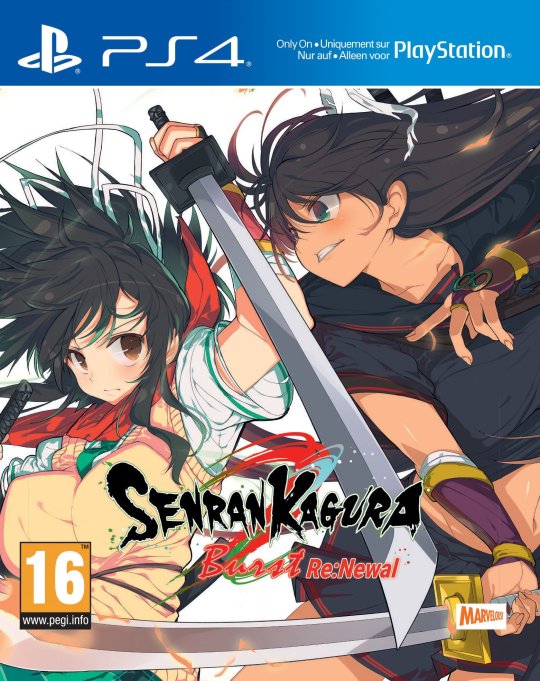
(Platform(s): PS4, PC | Release Date: 18th Jan)
Woah, that last one got a little emotional there. Anyways, this one’s an easy sell: BOOBS, BUTTS, ANIME BABES, & BODACIOUS BLADES. Senran Kagura Estival Versus was a interesting musou that showcased some promising gameplay elements; I actually had to activate more than two brain cells at once, during my playthrough. Shocking, I know. Senran Kagura Burst Re:Newal is a remake of a 3DS game (Senran Kagura Burst), which consists of gameplay more akin to a 3D-Beat-’em-up. It simply looks like a bit of a meatier Estival Versus so I’m keen to check it out & see how deep the game mechanics well is. If you’re looking for a fun light action romp too, you should as well. The presentation, which I won’t delve into here, is often what is a bit of a turn off for newcomers - I personally have never been swayed by it either way it. Sure, it’s a bit saucy but it doesn’t detract from the fact that whatever the Senran Kagura series tries its hand at, is often a pretty fun & polished experience, albeit a slightly shallow one. This one isn’t necessarily a ‘must get’ but they’re not charging full price so it is definitely worth an investigative playthrough, if you can get past the ‘fan-service-y’ presentation.
Well, that’s it for the first volume of ‘What the hey, AJ?’ Next time, I hope to adapt this into video form & hopefully spin in a few funnies, as well as just tighten up the structure. Next time, probably won’t be all new releases either - I’ll probably end up doing another just if I find that everything I’m playing, at any given time, is amazing. I have, and always will be, MetaVanAJ - stay cool, fools. Actually, that was mean calling my audience fools. Stay cool, individuals.
0 notes